Financial Statement Analysis Report
VerifiedAdded on 2023/04/17
|18
|3460
|404
AI Summary
This report aims at analyzing and understanding the material misstatement and restatement of financial information in the financial statement of an entity. For better utilization of financial information and better decision making the accounting system should be transparent and proper disclosure principles should be followed. In this report, the case study of Avid Technologies is chosen for analysis of those schools of accounting in the view of respective GAAP and IFRSs. Lastly, the paper concludes with some affects of such restatement and possible way outs for betterment of the financial reporting system.
Contribute Materials
Your contribution can guide someone’s learning journey. Share your
documents today.
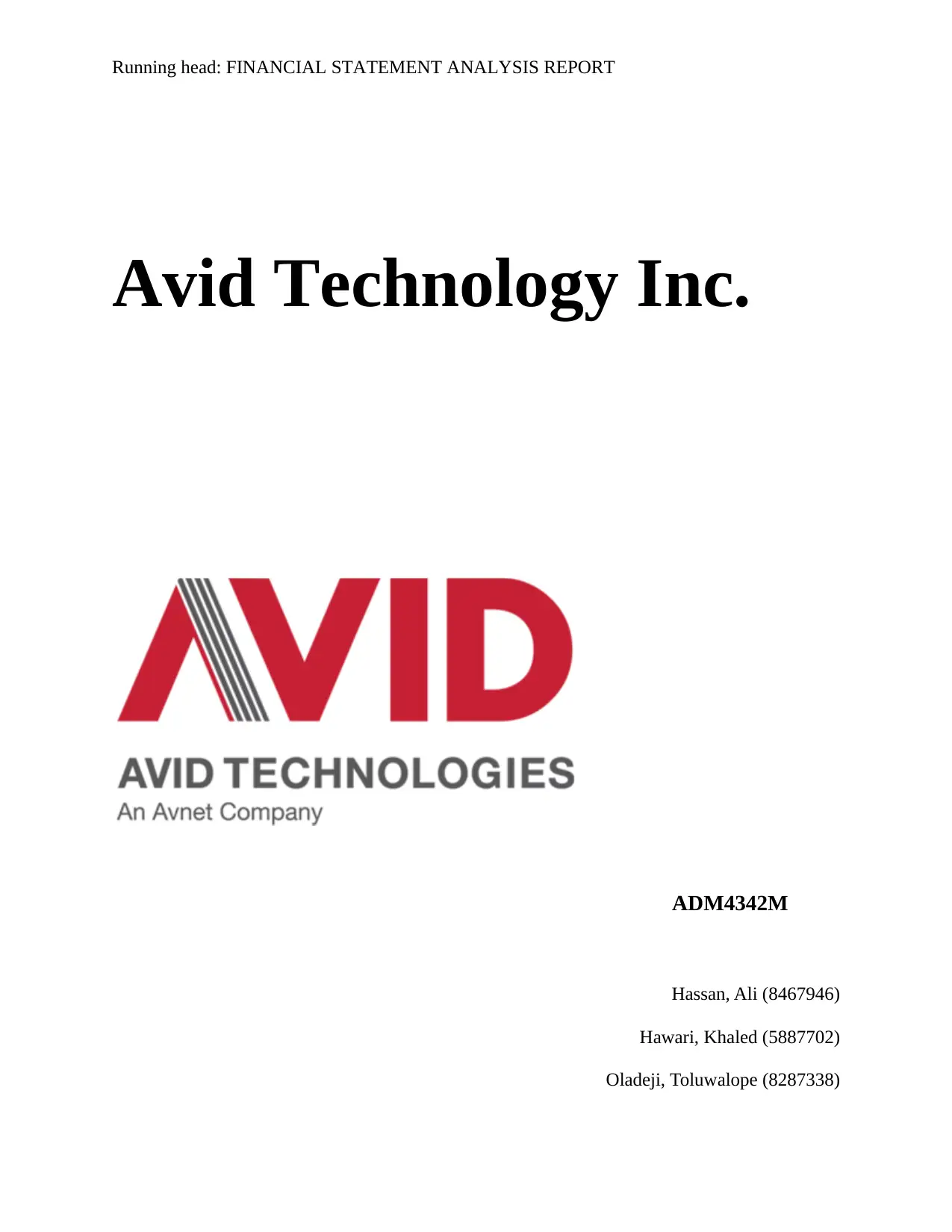
Running head: FINANCIAL STATEMENT ANALYSIS REPORT
Avid Technology Inc.
ADM4342M
Hassan, Ali (8467946)
Hawari, Khaled (5887702)
Oladeji, Toluwalope (8287338)
Avid Technology Inc.
ADM4342M
Hassan, Ali (8467946)
Hawari, Khaled (5887702)
Oladeji, Toluwalope (8287338)
Secure Best Marks with AI Grader
Need help grading? Try our AI Grader for instant feedback on your assignments.
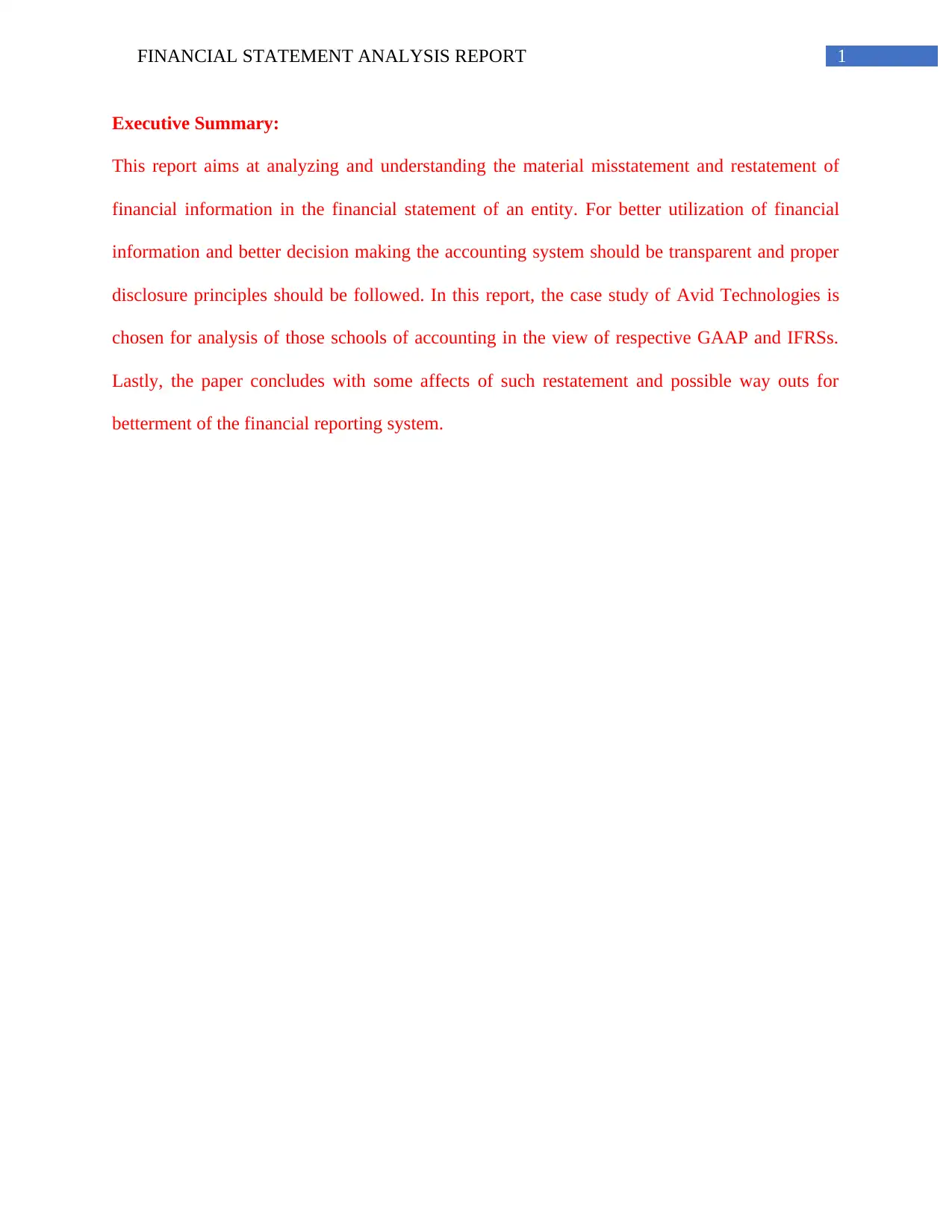
1FINANCIAL STATEMENT ANALYSIS REPORT
Executive Summary:
This report aims at analyzing and understanding the material misstatement and restatement of
financial information in the financial statement of an entity. For better utilization of financial
information and better decision making the accounting system should be transparent and proper
disclosure principles should be followed. In this report, the case study of Avid Technologies is
chosen for analysis of those schools of accounting in the view of respective GAAP and IFRSs.
Lastly, the paper concludes with some affects of such restatement and possible way outs for
betterment of the financial reporting system.
Executive Summary:
This report aims at analyzing and understanding the material misstatement and restatement of
financial information in the financial statement of an entity. For better utilization of financial
information and better decision making the accounting system should be transparent and proper
disclosure principles should be followed. In this report, the case study of Avid Technologies is
chosen for analysis of those schools of accounting in the view of respective GAAP and IFRSs.
Lastly, the paper concludes with some affects of such restatement and possible way outs for
betterment of the financial reporting system.
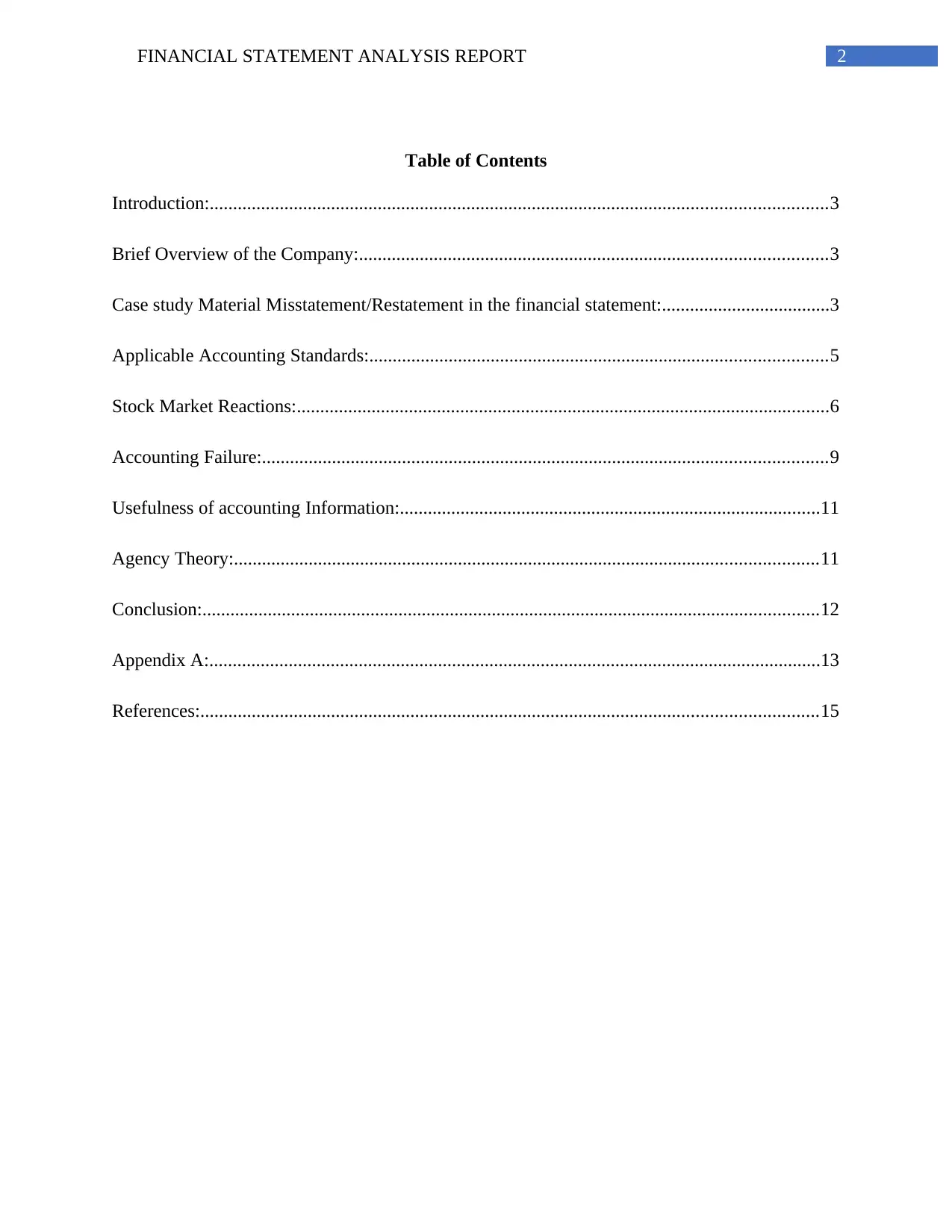
2FINANCIAL STATEMENT ANALYSIS REPORT
Table of Contents
Introduction:....................................................................................................................................3
Brief Overview of the Company:....................................................................................................3
Case study Material Misstatement/Restatement in the financial statement:....................................3
Applicable Accounting Standards:..................................................................................................5
Stock Market Reactions:..................................................................................................................6
Accounting Failure:.........................................................................................................................9
Usefulness of accounting Information:..........................................................................................11
Agency Theory:.............................................................................................................................11
Conclusion:....................................................................................................................................12
Appendix A:...................................................................................................................................13
References:....................................................................................................................................15
Table of Contents
Introduction:....................................................................................................................................3
Brief Overview of the Company:....................................................................................................3
Case study Material Misstatement/Restatement in the financial statement:....................................3
Applicable Accounting Standards:..................................................................................................5
Stock Market Reactions:..................................................................................................................6
Accounting Failure:.........................................................................................................................9
Usefulness of accounting Information:..........................................................................................11
Agency Theory:.............................................................................................................................11
Conclusion:....................................................................................................................................12
Appendix A:...................................................................................................................................13
References:....................................................................................................................................15
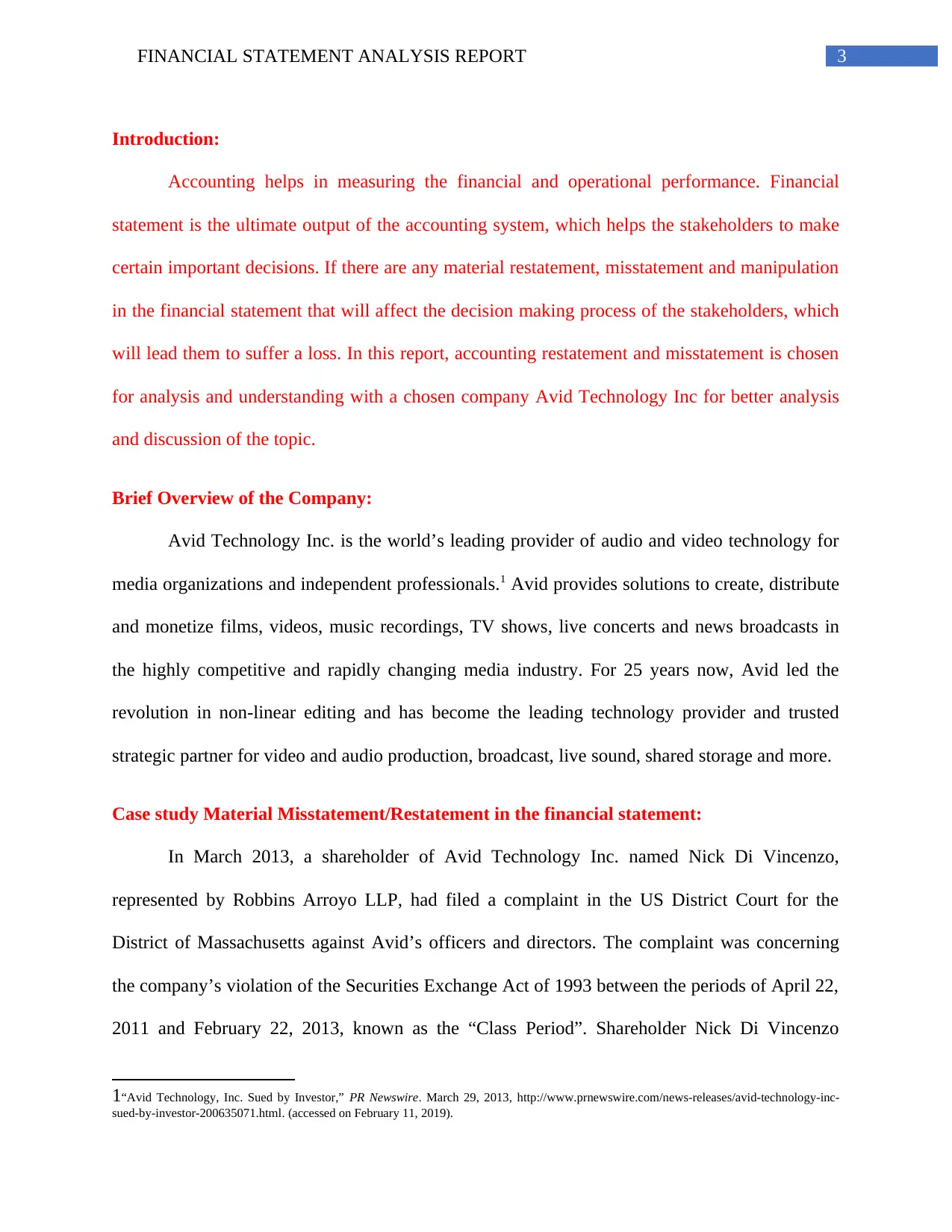
3FINANCIAL STATEMENT ANALYSIS REPORT
Introduction:
Accounting helps in measuring the financial and operational performance. Financial
statement is the ultimate output of the accounting system, which helps the stakeholders to make
certain important decisions. If there are any material restatement, misstatement and manipulation
in the financial statement that will affect the decision making process of the stakeholders, which
will lead them to suffer a loss. In this report, accounting restatement and misstatement is chosen
for analysis and understanding with a chosen company Avid Technology Inc for better analysis
and discussion of the topic.
Brief Overview of the Company:
Avid Technology Inc. is the world’s leading provider of audio and video technology for
media organizations and independent professionals.1 Avid provides solutions to create, distribute
and monetize films, videos, music recordings, TV shows, live concerts and news broadcasts in
the highly competitive and rapidly changing media industry. For 25 years now, Avid led the
revolution in non-linear editing and has become the leading technology provider and trusted
strategic partner for video and audio production, broadcast, live sound, shared storage and more.
Case study Material Misstatement/Restatement in the financial statement:
In March 2013, a shareholder of Avid Technology Inc. named Nick Di Vincenzo,
represented by Robbins Arroyo LLP, had filed a complaint in the US District Court for the
District of Massachusetts against Avid’s officers and directors. The complaint was concerning
the company’s violation of the Securities Exchange Act of 1993 between the periods of April 22,
2011 and February 22, 2013, known as the “Class Period”. Shareholder Nick Di Vincenzo
1“Avid Technology, Inc. Sued by Investor,” PR Newswire. March 29, 2013, http://www.prnewswire.com/news-releases/avid-technology-inc-
sued-by-investor-200635071.html. (accessed on February 11, 2019).
Introduction:
Accounting helps in measuring the financial and operational performance. Financial
statement is the ultimate output of the accounting system, which helps the stakeholders to make
certain important decisions. If there are any material restatement, misstatement and manipulation
in the financial statement that will affect the decision making process of the stakeholders, which
will lead them to suffer a loss. In this report, accounting restatement and misstatement is chosen
for analysis and understanding with a chosen company Avid Technology Inc for better analysis
and discussion of the topic.
Brief Overview of the Company:
Avid Technology Inc. is the world’s leading provider of audio and video technology for
media organizations and independent professionals.1 Avid provides solutions to create, distribute
and monetize films, videos, music recordings, TV shows, live concerts and news broadcasts in
the highly competitive and rapidly changing media industry. For 25 years now, Avid led the
revolution in non-linear editing and has become the leading technology provider and trusted
strategic partner for video and audio production, broadcast, live sound, shared storage and more.
Case study Material Misstatement/Restatement in the financial statement:
In March 2013, a shareholder of Avid Technology Inc. named Nick Di Vincenzo,
represented by Robbins Arroyo LLP, had filed a complaint in the US District Court for the
District of Massachusetts against Avid’s officers and directors. The complaint was concerning
the company’s violation of the Securities Exchange Act of 1993 between the periods of April 22,
2011 and February 22, 2013, known as the “Class Period”. Shareholder Nick Di Vincenzo
1“Avid Technology, Inc. Sued by Investor,” PR Newswire. March 29, 2013, http://www.prnewswire.com/news-releases/avid-technology-inc-
sued-by-investor-200635071.html. (accessed on February 11, 2019).
Secure Best Marks with AI Grader
Need help grading? Try our AI Grader for instant feedback on your assignments.
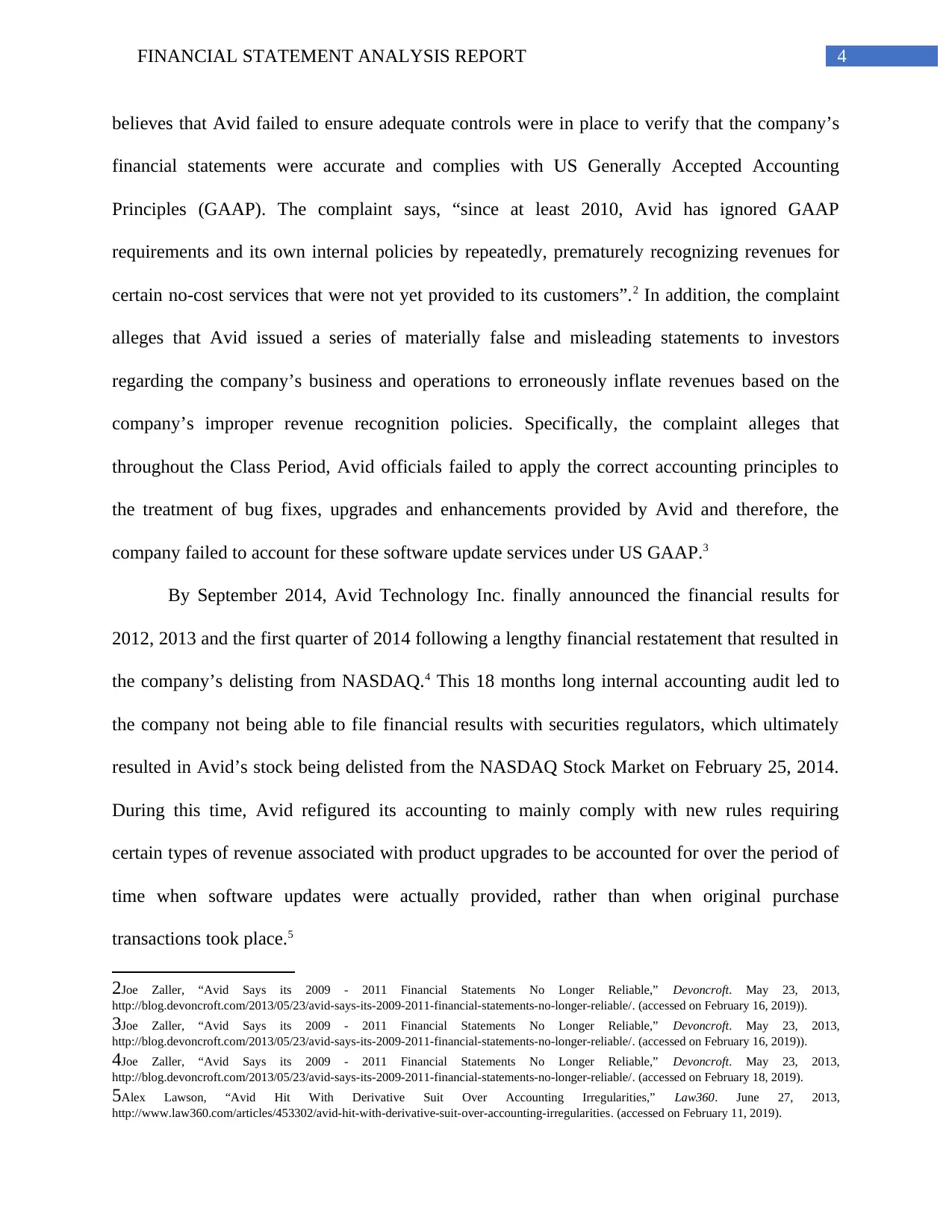
4FINANCIAL STATEMENT ANALYSIS REPORT
believes that Avid failed to ensure adequate controls were in place to verify that the company’s
financial statements were accurate and complies with US Generally Accepted Accounting
Principles (GAAP). The complaint says, “since at least 2010, Avid has ignored GAAP
requirements and its own internal policies by repeatedly, prematurely recognizing revenues for
certain no-cost services that were not yet provided to its customers”.2 In addition, the complaint
alleges that Avid issued a series of materially false and misleading statements to investors
regarding the company’s business and operations to erroneously inflate revenues based on the
company’s improper revenue recognition policies. Specifically, the complaint alleges that
throughout the Class Period, Avid officials failed to apply the correct accounting principles to
the treatment of bug fixes, upgrades and enhancements provided by Avid and therefore, the
company failed to account for these software update services under US GAAP.3
By September 2014, Avid Technology Inc. finally announced the financial results for
2012, 2013 and the first quarter of 2014 following a lengthy financial restatement that resulted in
the company’s delisting from NASDAQ.4 This 18 months long internal accounting audit led to
the company not being able to file financial results with securities regulators, which ultimately
resulted in Avid’s stock being delisted from the NASDAQ Stock Market on February 25, 2014.
During this time, Avid refigured its accounting to mainly comply with new rules requiring
certain types of revenue associated with product upgrades to be accounted for over the period of
time when software updates were actually provided, rather than when original purchase
transactions took place.5
2Joe Zaller, “Avid Says its 2009 - 2011 Financial Statements No Longer Reliable,” Devoncroft. May 23, 2013,
http://blog.devoncroft.com/2013/05/23/avid-says-its-2009-2011-financial-statements-no-longer-reliable/. (accessed on February 16, 2019)).
3Joe Zaller, “Avid Says its 2009 - 2011 Financial Statements No Longer Reliable,” Devoncroft. May 23, 2013,
http://blog.devoncroft.com/2013/05/23/avid-says-its-2009-2011-financial-statements-no-longer-reliable/. (accessed on February 16, 2019)).
4Joe Zaller, “Avid Says its 2009 - 2011 Financial Statements No Longer Reliable,” Devoncroft. May 23, 2013,
http://blog.devoncroft.com/2013/05/23/avid-says-its-2009-2011-financial-statements-no-longer-reliable/. (accessed on February 18, 2019).
5Alex Lawson, “Avid Hit With Derivative Suit Over Accounting Irregularities,” Law360. June 27, 2013,
http://www.law360.com/articles/453302/avid-hit-with-derivative-suit-over-accounting-irregularities. (accessed on February 11, 2019).
believes that Avid failed to ensure adequate controls were in place to verify that the company’s
financial statements were accurate and complies with US Generally Accepted Accounting
Principles (GAAP). The complaint says, “since at least 2010, Avid has ignored GAAP
requirements and its own internal policies by repeatedly, prematurely recognizing revenues for
certain no-cost services that were not yet provided to its customers”.2 In addition, the complaint
alleges that Avid issued a series of materially false and misleading statements to investors
regarding the company’s business and operations to erroneously inflate revenues based on the
company’s improper revenue recognition policies. Specifically, the complaint alleges that
throughout the Class Period, Avid officials failed to apply the correct accounting principles to
the treatment of bug fixes, upgrades and enhancements provided by Avid and therefore, the
company failed to account for these software update services under US GAAP.3
By September 2014, Avid Technology Inc. finally announced the financial results for
2012, 2013 and the first quarter of 2014 following a lengthy financial restatement that resulted in
the company’s delisting from NASDAQ.4 This 18 months long internal accounting audit led to
the company not being able to file financial results with securities regulators, which ultimately
resulted in Avid’s stock being delisted from the NASDAQ Stock Market on February 25, 2014.
During this time, Avid refigured its accounting to mainly comply with new rules requiring
certain types of revenue associated with product upgrades to be accounted for over the period of
time when software updates were actually provided, rather than when original purchase
transactions took place.5
2Joe Zaller, “Avid Says its 2009 - 2011 Financial Statements No Longer Reliable,” Devoncroft. May 23, 2013,
http://blog.devoncroft.com/2013/05/23/avid-says-its-2009-2011-financial-statements-no-longer-reliable/. (accessed on February 16, 2019)).
3Joe Zaller, “Avid Says its 2009 - 2011 Financial Statements No Longer Reliable,” Devoncroft. May 23, 2013,
http://blog.devoncroft.com/2013/05/23/avid-says-its-2009-2011-financial-statements-no-longer-reliable/. (accessed on February 16, 2019)).
4Joe Zaller, “Avid Says its 2009 - 2011 Financial Statements No Longer Reliable,” Devoncroft. May 23, 2013,
http://blog.devoncroft.com/2013/05/23/avid-says-its-2009-2011-financial-statements-no-longer-reliable/. (accessed on February 18, 2019).
5Alex Lawson, “Avid Hit With Derivative Suit Over Accounting Irregularities,” Law360. June 27, 2013,
http://www.law360.com/articles/453302/avid-hit-with-derivative-suit-over-accounting-irregularities. (accessed on February 11, 2019).
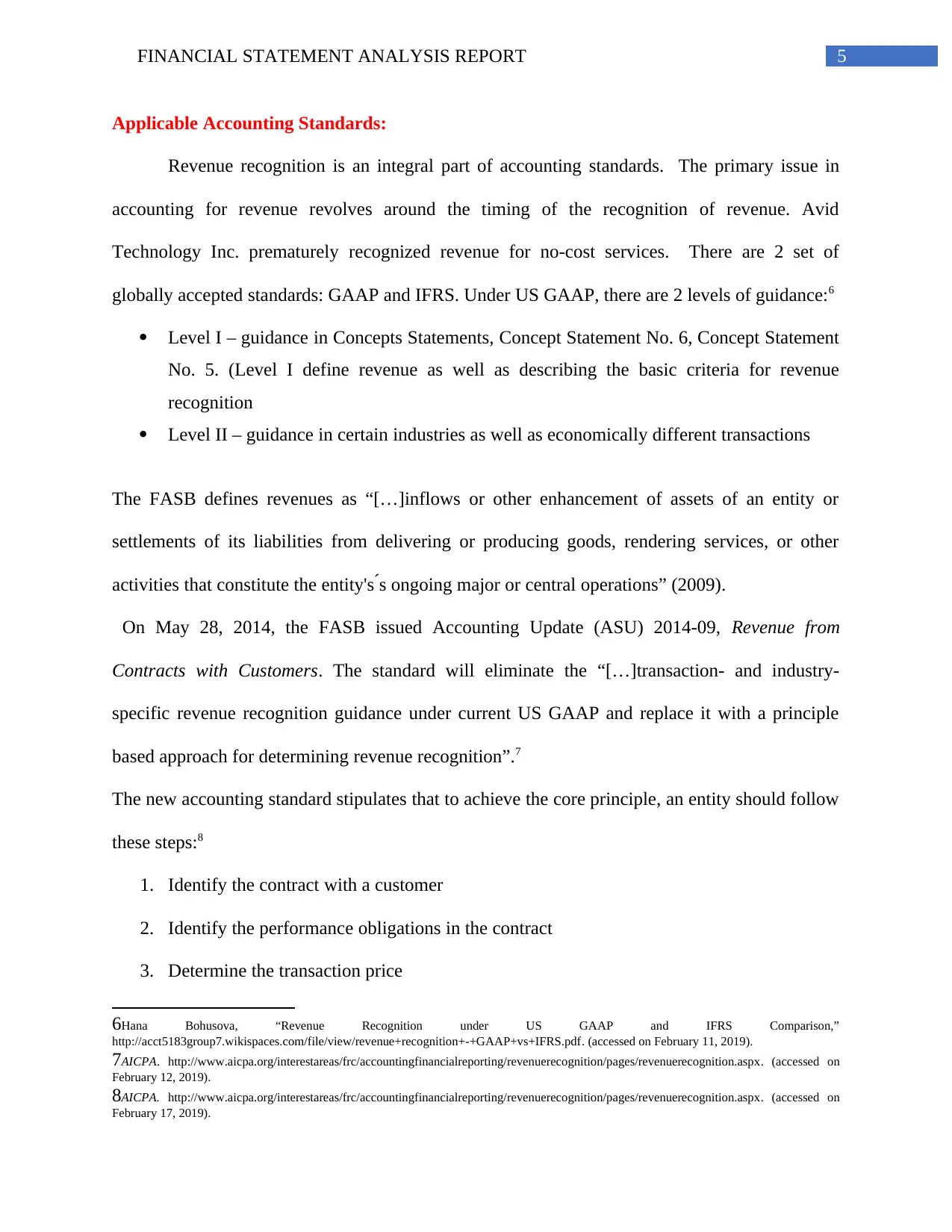
5FINANCIAL STATEMENT ANALYSIS REPORT
Applicable Accounting Standards:
Revenue recognition is an integral part of accounting standards. The primary issue in
accounting for revenue revolves around the timing of the recognition of revenue. Avid
Technology Inc. prematurely recognized revenue for no-cost services. There are 2 set of
globally accepted standards: GAAP and IFRS. Under US GAAP, there are 2 levels of guidance:6
Level I – guidance in Concepts Statements, Concept Statement No. 6, Concept Statement
No. 5. (Level I define revenue as well as describing the basic criteria for revenue
recognition
Level II – guidance in certain industries as well as economically different transactions
The FASB defines revenues as “[…]inflows or other enhancement of assets of an entity or
settlements of its liabilities from delivering or producing goods, rendering services, or other
activities that constitute the entity's ́ s ongoing major or central operations” (2009).
On May 28, 2014, the FASB issued Accounting Update (ASU) 2014-09, Revenue from
Contracts with Customers. The standard will eliminate the “[…]transaction- and industry-
specific revenue recognition guidance under current US GAAP and replace it with a principle
based approach for determining revenue recognition”.7
The new accounting standard stipulates that to achieve the core principle, an entity should follow
these steps:8
1. Identify the contract with a customer
2. Identify the performance obligations in the contract
3. Determine the transaction price
6Hana Bohusova, “Revenue Recognition under US GAAP and IFRS Comparison,”
http://acct5183group7.wikispaces.com/file/view/revenue+recognition+-+GAAP+vs+IFRS.pdf. (accessed on February 11, 2019).
7AICPA. http://www.aicpa.org/interestareas/frc/accountingfinancialreporting/revenuerecognition/pages/revenuerecognition.aspx. (accessed on
February 12, 2019).
8AICPA. http://www.aicpa.org/interestareas/frc/accountingfinancialreporting/revenuerecognition/pages/revenuerecognition.aspx. (accessed on
February 17, 2019).
Applicable Accounting Standards:
Revenue recognition is an integral part of accounting standards. The primary issue in
accounting for revenue revolves around the timing of the recognition of revenue. Avid
Technology Inc. prematurely recognized revenue for no-cost services. There are 2 set of
globally accepted standards: GAAP and IFRS. Under US GAAP, there are 2 levels of guidance:6
Level I – guidance in Concepts Statements, Concept Statement No. 6, Concept Statement
No. 5. (Level I define revenue as well as describing the basic criteria for revenue
recognition
Level II – guidance in certain industries as well as economically different transactions
The FASB defines revenues as “[…]inflows or other enhancement of assets of an entity or
settlements of its liabilities from delivering or producing goods, rendering services, or other
activities that constitute the entity's ́ s ongoing major or central operations” (2009).
On May 28, 2014, the FASB issued Accounting Update (ASU) 2014-09, Revenue from
Contracts with Customers. The standard will eliminate the “[…]transaction- and industry-
specific revenue recognition guidance under current US GAAP and replace it with a principle
based approach for determining revenue recognition”.7
The new accounting standard stipulates that to achieve the core principle, an entity should follow
these steps:8
1. Identify the contract with a customer
2. Identify the performance obligations in the contract
3. Determine the transaction price
6Hana Bohusova, “Revenue Recognition under US GAAP and IFRS Comparison,”
http://acct5183group7.wikispaces.com/file/view/revenue+recognition+-+GAAP+vs+IFRS.pdf. (accessed on February 11, 2019).
7AICPA. http://www.aicpa.org/interestareas/frc/accountingfinancialreporting/revenuerecognition/pages/revenuerecognition.aspx. (accessed on
February 12, 2019).
8AICPA. http://www.aicpa.org/interestareas/frc/accountingfinancialreporting/revenuerecognition/pages/revenuerecognition.aspx. (accessed on
February 17, 2019).
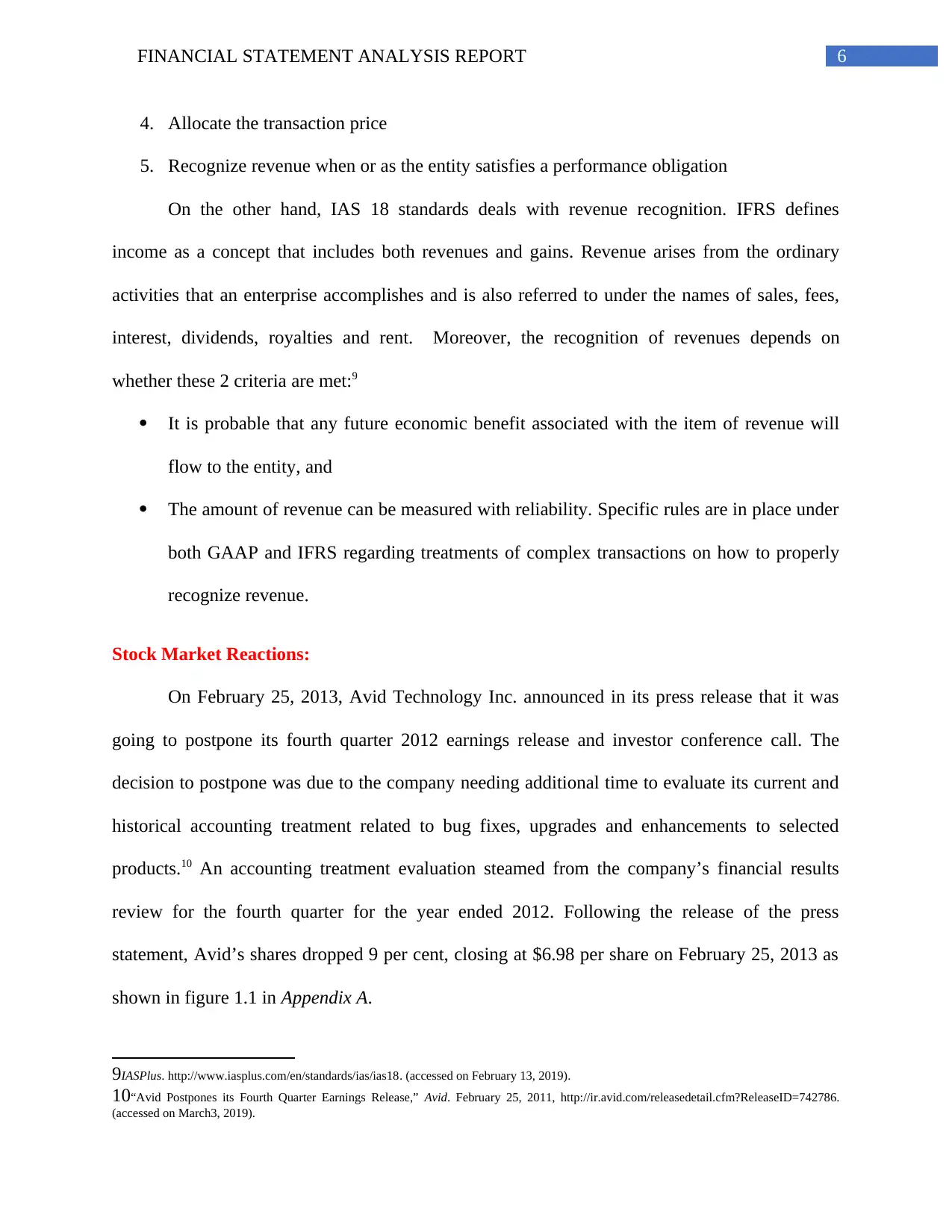
6FINANCIAL STATEMENT ANALYSIS REPORT
4. Allocate the transaction price
5. Recognize revenue when or as the entity satisfies a performance obligation
On the other hand, IAS 18 standards deals with revenue recognition. IFRS defines
income as a concept that includes both revenues and gains. Revenue arises from the ordinary
activities that an enterprise accomplishes and is also referred to under the names of sales, fees,
interest, dividends, royalties and rent. Moreover, the recognition of revenues depends on
whether these 2 criteria are met:9
It is probable that any future economic benefit associated with the item of revenue will
flow to the entity, and
The amount of revenue can be measured with reliability. Specific rules are in place under
both GAAP and IFRS regarding treatments of complex transactions on how to properly
recognize revenue.
Stock Market Reactions:
On February 25, 2013, Avid Technology Inc. announced in its press release that it was
going to postpone its fourth quarter 2012 earnings release and investor conference call. The
decision to postpone was due to the company needing additional time to evaluate its current and
historical accounting treatment related to bug fixes, upgrades and enhancements to selected
products.10 An accounting treatment evaluation steamed from the company’s financial results
review for the fourth quarter for the year ended 2012. Following the release of the press
statement, Avid’s shares dropped 9 per cent, closing at $6.98 per share on February 25, 2013 as
shown in figure 1.1 in Appendix A.
9IASPlus. http://www.iasplus.com/en/standards/ias/ias18. (accessed on February 13, 2019).
10“Avid Postpones its Fourth Quarter Earnings Release,” Avid. February 25, 2011, http://ir.avid.com/releasedetail.cfm?ReleaseID=742786.
(accessed on March3, 2019).
4. Allocate the transaction price
5. Recognize revenue when or as the entity satisfies a performance obligation
On the other hand, IAS 18 standards deals with revenue recognition. IFRS defines
income as a concept that includes both revenues and gains. Revenue arises from the ordinary
activities that an enterprise accomplishes and is also referred to under the names of sales, fees,
interest, dividends, royalties and rent. Moreover, the recognition of revenues depends on
whether these 2 criteria are met:9
It is probable that any future economic benefit associated with the item of revenue will
flow to the entity, and
The amount of revenue can be measured with reliability. Specific rules are in place under
both GAAP and IFRS regarding treatments of complex transactions on how to properly
recognize revenue.
Stock Market Reactions:
On February 25, 2013, Avid Technology Inc. announced in its press release that it was
going to postpone its fourth quarter 2012 earnings release and investor conference call. The
decision to postpone was due to the company needing additional time to evaluate its current and
historical accounting treatment related to bug fixes, upgrades and enhancements to selected
products.10 An accounting treatment evaluation steamed from the company’s financial results
review for the fourth quarter for the year ended 2012. Following the release of the press
statement, Avid’s shares dropped 9 per cent, closing at $6.98 per share on February 25, 2013 as
shown in figure 1.1 in Appendix A.
9IASPlus. http://www.iasplus.com/en/standards/ias/ias18. (accessed on February 13, 2019).
10“Avid Postpones its Fourth Quarter Earnings Release,” Avid. February 25, 2011, http://ir.avid.com/releasedetail.cfm?ReleaseID=742786.
(accessed on March3, 2019).
Paraphrase This Document
Need a fresh take? Get an instant paraphrase of this document with our AI Paraphraser
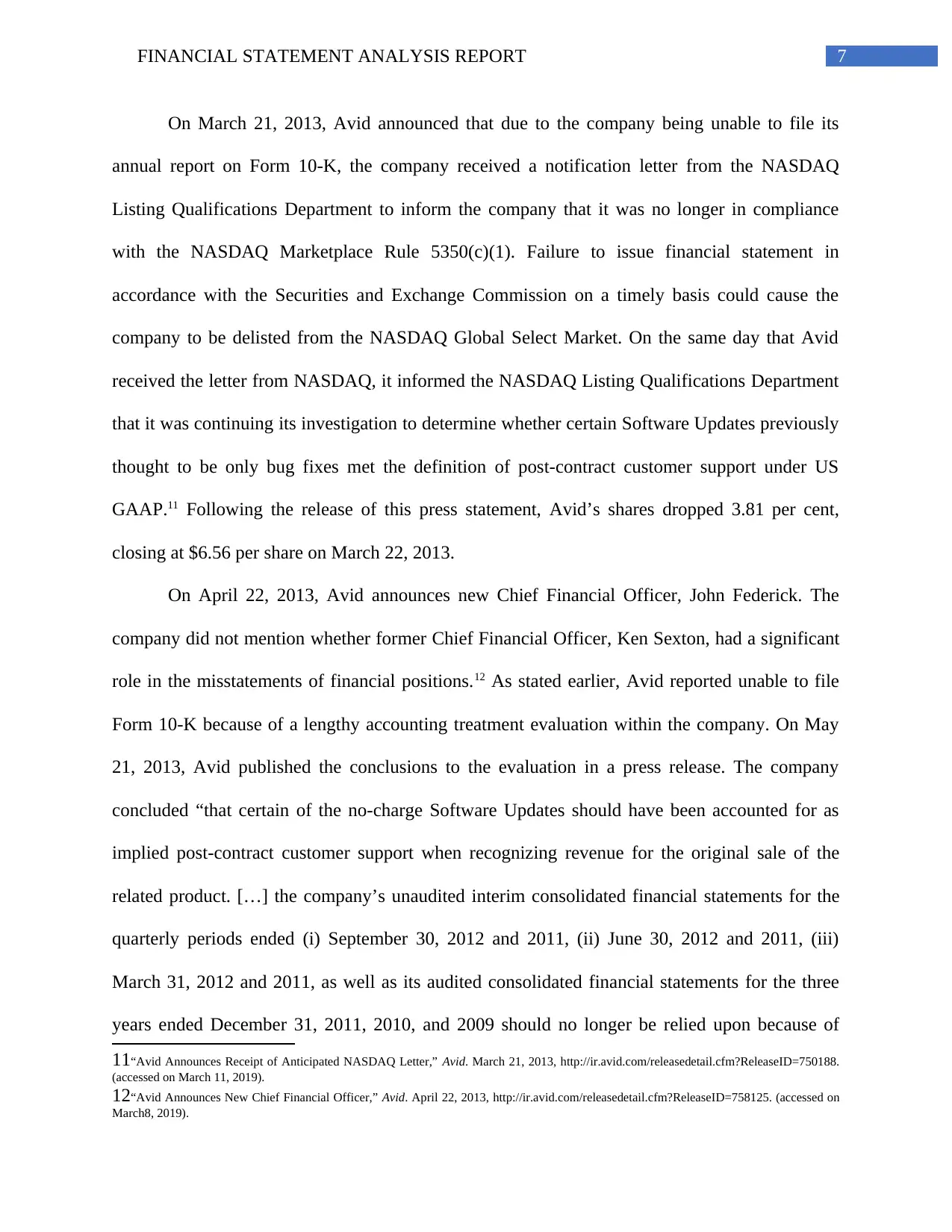
7FINANCIAL STATEMENT ANALYSIS REPORT
On March 21, 2013, Avid announced that due to the company being unable to file its
annual report on Form 10-K, the company received a notification letter from the NASDAQ
Listing Qualifications Department to inform the company that it was no longer in compliance
with the NASDAQ Marketplace Rule 5350(c)(1). Failure to issue financial statement in
accordance with the Securities and Exchange Commission on a timely basis could cause the
company to be delisted from the NASDAQ Global Select Market. On the same day that Avid
received the letter from NASDAQ, it informed the NASDAQ Listing Qualifications Department
that it was continuing its investigation to determine whether certain Software Updates previously
thought to be only bug fixes met the definition of post-contract customer support under US
GAAP.11 Following the release of this press statement, Avid’s shares dropped 3.81 per cent,
closing at $6.56 per share on March 22, 2013.
On April 22, 2013, Avid announces new Chief Financial Officer, John Federick. The
company did not mention whether former Chief Financial Officer, Ken Sexton, had a significant
role in the misstatements of financial positions.12 As stated earlier, Avid reported unable to file
Form 10-K because of a lengthy accounting treatment evaluation within the company. On May
21, 2013, Avid published the conclusions to the evaluation in a press release. The company
concluded “that certain of the no-charge Software Updates should have been accounted for as
implied post-contract customer support when recognizing revenue for the original sale of the
related product. […] the company’s unaudited interim consolidated financial statements for the
quarterly periods ended (i) September 30, 2012 and 2011, (ii) June 30, 2012 and 2011, (iii)
March 31, 2012 and 2011, as well as its audited consolidated financial statements for the three
years ended December 31, 2011, 2010, and 2009 should no longer be relied upon because of
11“Avid Announces Receipt of Anticipated NASDAQ Letter,” Avid. March 21, 2013, http://ir.avid.com/releasedetail.cfm?ReleaseID=750188.
(accessed on March 11, 2019).
12“Avid Announces New Chief Financial Officer,” Avid. April 22, 2013, http://ir.avid.com/releasedetail.cfm?ReleaseID=758125. (accessed on
March8, 2019).
On March 21, 2013, Avid announced that due to the company being unable to file its
annual report on Form 10-K, the company received a notification letter from the NASDAQ
Listing Qualifications Department to inform the company that it was no longer in compliance
with the NASDAQ Marketplace Rule 5350(c)(1). Failure to issue financial statement in
accordance with the Securities and Exchange Commission on a timely basis could cause the
company to be delisted from the NASDAQ Global Select Market. On the same day that Avid
received the letter from NASDAQ, it informed the NASDAQ Listing Qualifications Department
that it was continuing its investigation to determine whether certain Software Updates previously
thought to be only bug fixes met the definition of post-contract customer support under US
GAAP.11 Following the release of this press statement, Avid’s shares dropped 3.81 per cent,
closing at $6.56 per share on March 22, 2013.
On April 22, 2013, Avid announces new Chief Financial Officer, John Federick. The
company did not mention whether former Chief Financial Officer, Ken Sexton, had a significant
role in the misstatements of financial positions.12 As stated earlier, Avid reported unable to file
Form 10-K because of a lengthy accounting treatment evaluation within the company. On May
21, 2013, Avid published the conclusions to the evaluation in a press release. The company
concluded “that certain of the no-charge Software Updates should have been accounted for as
implied post-contract customer support when recognizing revenue for the original sale of the
related product. […] the company’s unaudited interim consolidated financial statements for the
quarterly periods ended (i) September 30, 2012 and 2011, (ii) June 30, 2012 and 2011, (iii)
March 31, 2012 and 2011, as well as its audited consolidated financial statements for the three
years ended December 31, 2011, 2010, and 2009 should no longer be relied upon because of
11“Avid Announces Receipt of Anticipated NASDAQ Letter,” Avid. March 21, 2013, http://ir.avid.com/releasedetail.cfm?ReleaseID=750188.
(accessed on March 11, 2019).
12“Avid Announces New Chief Financial Officer,” Avid. April 22, 2013, http://ir.avid.com/releasedetail.cfm?ReleaseID=758125. (accessed on
March8, 2019).
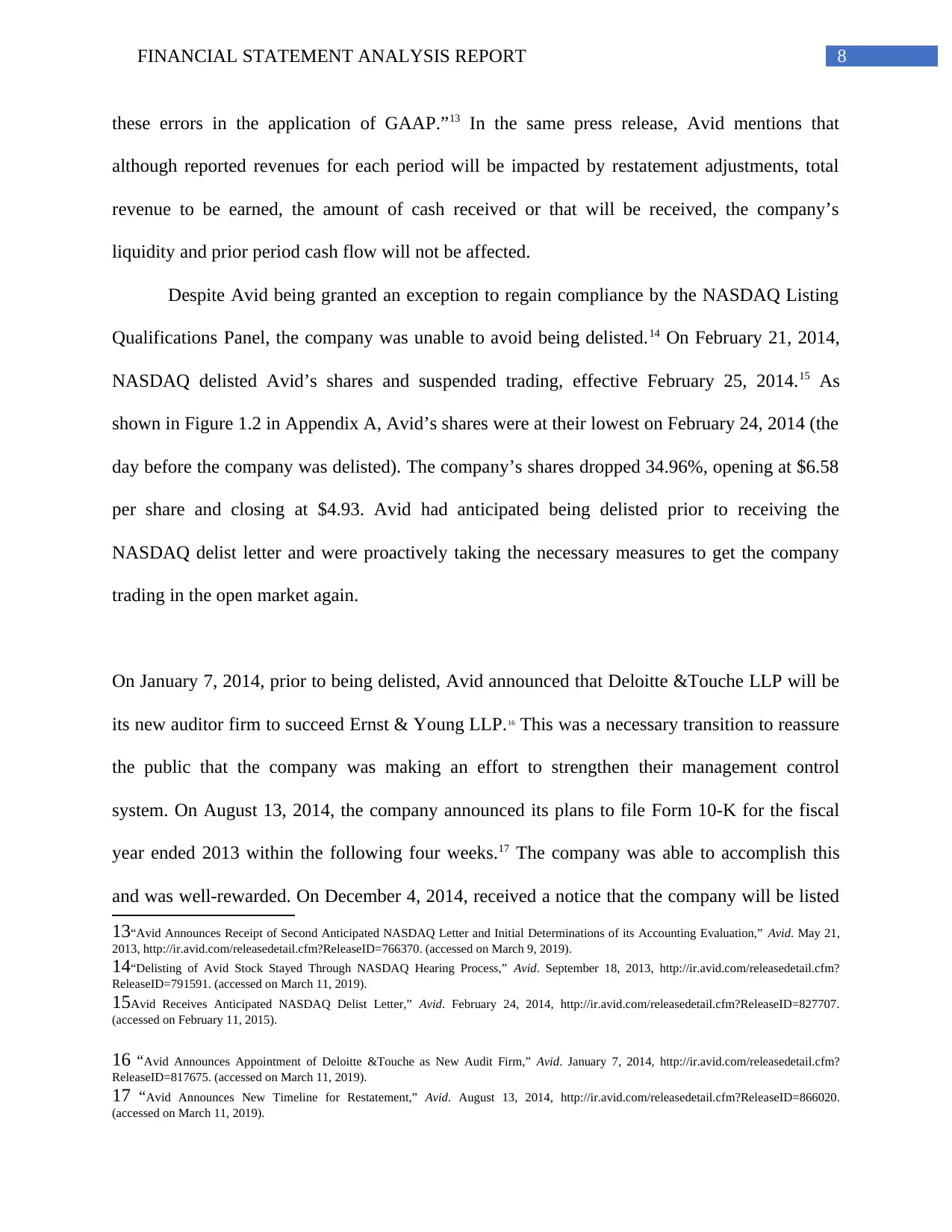
8FINANCIAL STATEMENT ANALYSIS REPORT
these errors in the application of GAAP.”13 In the same press release, Avid mentions that
although reported revenues for each period will be impacted by restatement adjustments, total
revenue to be earned, the amount of cash received or that will be received, the company’s
liquidity and prior period cash flow will not be affected.
Despite Avid being granted an exception to regain compliance by the NASDAQ Listing
Qualifications Panel, the company was unable to avoid being delisted.14 On February 21, 2014,
NASDAQ delisted Avid’s shares and suspended trading, effective February 25, 2014.15 As
shown in Figure 1.2 in Appendix A, Avid’s shares were at their lowest on February 24, 2014 (the
day before the company was delisted). The company’s shares dropped 34.96%, opening at $6.58
per share and closing at $4.93. Avid had anticipated being delisted prior to receiving the
NASDAQ delist letter and were proactively taking the necessary measures to get the company
trading in the open market again.
On January 7, 2014, prior to being delisted, Avid announced that Deloitte &Touche LLP will be
its new auditor firm to succeed Ernst & Young LLP.16 This was a necessary transition to reassure
the public that the company was making an effort to strengthen their management control
system. On August 13, 2014, the company announced its plans to file Form 10-K for the fiscal
year ended 2013 within the following four weeks.17 The company was able to accomplish this
and was well-rewarded. On December 4, 2014, received a notice that the company will be listed
13“Avid Announces Receipt of Second Anticipated NASDAQ Letter and Initial Determinations of its Accounting Evaluation,” Avid. May 21,
2013, http://ir.avid.com/releasedetail.cfm?ReleaseID=766370. (accessed on March 9, 2019).
14“Delisting of Avid Stock Stayed Through NASDAQ Hearing Process,” Avid. September 18, 2013, http://ir.avid.com/releasedetail.cfm?
ReleaseID=791591. (accessed on March 11, 2019).
15Avid Receives Anticipated NASDAQ Delist Letter,” Avid. February 24, 2014, http://ir.avid.com/releasedetail.cfm?ReleaseID=827707.
(accessed on February 11, 2015).
16 “Avid Announces Appointment of Deloitte &Touche as New Audit Firm,” Avid. January 7, 2014, http://ir.avid.com/releasedetail.cfm?
ReleaseID=817675. (accessed on March 11, 2019).
17 “Avid Announces New Timeline for Restatement,” Avid. August 13, 2014, http://ir.avid.com/releasedetail.cfm?ReleaseID=866020.
(accessed on March 11, 2019).
these errors in the application of GAAP.”13 In the same press release, Avid mentions that
although reported revenues for each period will be impacted by restatement adjustments, total
revenue to be earned, the amount of cash received or that will be received, the company’s
liquidity and prior period cash flow will not be affected.
Despite Avid being granted an exception to regain compliance by the NASDAQ Listing
Qualifications Panel, the company was unable to avoid being delisted.14 On February 21, 2014,
NASDAQ delisted Avid’s shares and suspended trading, effective February 25, 2014.15 As
shown in Figure 1.2 in Appendix A, Avid’s shares were at their lowest on February 24, 2014 (the
day before the company was delisted). The company’s shares dropped 34.96%, opening at $6.58
per share and closing at $4.93. Avid had anticipated being delisted prior to receiving the
NASDAQ delist letter and were proactively taking the necessary measures to get the company
trading in the open market again.
On January 7, 2014, prior to being delisted, Avid announced that Deloitte &Touche LLP will be
its new auditor firm to succeed Ernst & Young LLP.16 This was a necessary transition to reassure
the public that the company was making an effort to strengthen their management control
system. On August 13, 2014, the company announced its plans to file Form 10-K for the fiscal
year ended 2013 within the following four weeks.17 The company was able to accomplish this
and was well-rewarded. On December 4, 2014, received a notice that the company will be listed
13“Avid Announces Receipt of Second Anticipated NASDAQ Letter and Initial Determinations of its Accounting Evaluation,” Avid. May 21,
2013, http://ir.avid.com/releasedetail.cfm?ReleaseID=766370. (accessed on March 9, 2019).
14“Delisting of Avid Stock Stayed Through NASDAQ Hearing Process,” Avid. September 18, 2013, http://ir.avid.com/releasedetail.cfm?
ReleaseID=791591. (accessed on March 11, 2019).
15Avid Receives Anticipated NASDAQ Delist Letter,” Avid. February 24, 2014, http://ir.avid.com/releasedetail.cfm?ReleaseID=827707.
(accessed on February 11, 2015).
16 “Avid Announces Appointment of Deloitte &Touche as New Audit Firm,” Avid. January 7, 2014, http://ir.avid.com/releasedetail.cfm?
ReleaseID=817675. (accessed on March 11, 2019).
17 “Avid Announces New Timeline for Restatement,” Avid. August 13, 2014, http://ir.avid.com/releasedetail.cfm?ReleaseID=866020.
(accessed on March 11, 2019).
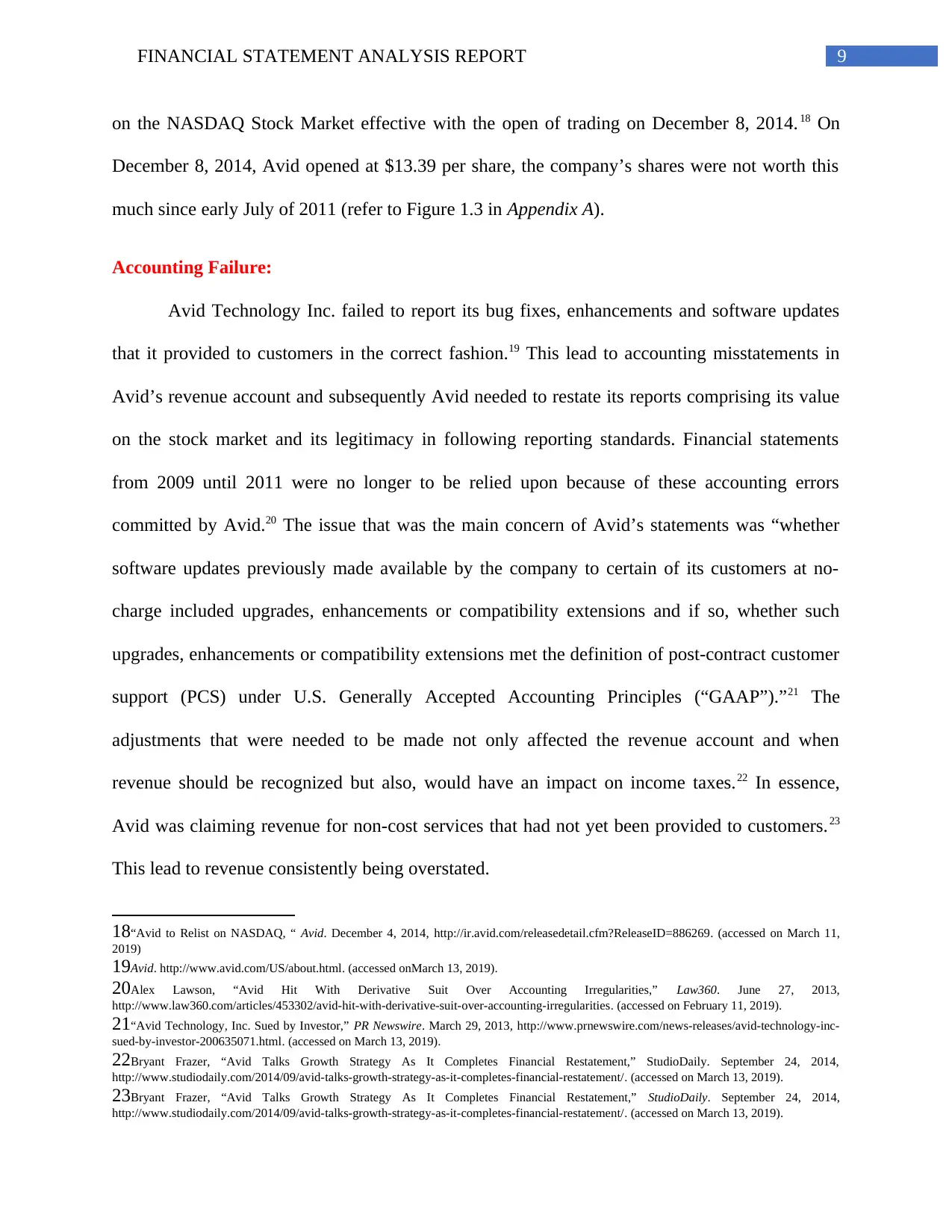
9FINANCIAL STATEMENT ANALYSIS REPORT
on the NASDAQ Stock Market effective with the open of trading on December 8, 2014.18 On
December 8, 2014, Avid opened at $13.39 per share, the company’s shares were not worth this
much since early July of 2011 (refer to Figure 1.3 in Appendix A).
Accounting Failure:
Avid Technology Inc. failed to report its bug fixes, enhancements and software updates
that it provided to customers in the correct fashion.19 This lead to accounting misstatements in
Avid’s revenue account and subsequently Avid needed to restate its reports comprising its value
on the stock market and its legitimacy in following reporting standards. Financial statements
from 2009 until 2011 were no longer to be relied upon because of these accounting errors
committed by Avid.20 The issue that was the main concern of Avid’s statements was “whether
software updates previously made available by the company to certain of its customers at no-
charge included upgrades, enhancements or compatibility extensions and if so, whether such
upgrades, enhancements or compatibility extensions met the definition of post-contract customer
support (PCS) under U.S. Generally Accepted Accounting Principles (“GAAP”).”21 The
adjustments that were needed to be made not only affected the revenue account and when
revenue should be recognized but also, would have an impact on income taxes.22 In essence,
Avid was claiming revenue for non-cost services that had not yet been provided to customers.23
This lead to revenue consistently being overstated.
18“Avid to Relist on NASDAQ, “ Avid. December 4, 2014, http://ir.avid.com/releasedetail.cfm?ReleaseID=886269. (accessed on March 11,
2019)
19Avid. http://www.avid.com/US/about.html. (accessed onMarch 13, 2019).
20Alex Lawson, “Avid Hit With Derivative Suit Over Accounting Irregularities,” Law360. June 27, 2013,
http://www.law360.com/articles/453302/avid-hit-with-derivative-suit-over-accounting-irregularities. (accessed on February 11, 2019).
21“Avid Technology, Inc. Sued by Investor,” PR Newswire. March 29, 2013, http://www.prnewswire.com/news-releases/avid-technology-inc-
sued-by-investor-200635071.html. (accessed on March 13, 2019).
22Bryant Frazer, “Avid Talks Growth Strategy As It Completes Financial Restatement,” StudioDaily. September 24, 2014,
http://www.studiodaily.com/2014/09/avid-talks-growth-strategy-as-it-completes-financial-restatement/. (accessed on March 13, 2019).
23Bryant Frazer, “Avid Talks Growth Strategy As It Completes Financial Restatement,” StudioDaily. September 24, 2014,
http://www.studiodaily.com/2014/09/avid-talks-growth-strategy-as-it-completes-financial-restatement/. (accessed on March 13, 2019).
on the NASDAQ Stock Market effective with the open of trading on December 8, 2014.18 On
December 8, 2014, Avid opened at $13.39 per share, the company’s shares were not worth this
much since early July of 2011 (refer to Figure 1.3 in Appendix A).
Accounting Failure:
Avid Technology Inc. failed to report its bug fixes, enhancements and software updates
that it provided to customers in the correct fashion.19 This lead to accounting misstatements in
Avid’s revenue account and subsequently Avid needed to restate its reports comprising its value
on the stock market and its legitimacy in following reporting standards. Financial statements
from 2009 until 2011 were no longer to be relied upon because of these accounting errors
committed by Avid.20 The issue that was the main concern of Avid’s statements was “whether
software updates previously made available by the company to certain of its customers at no-
charge included upgrades, enhancements or compatibility extensions and if so, whether such
upgrades, enhancements or compatibility extensions met the definition of post-contract customer
support (PCS) under U.S. Generally Accepted Accounting Principles (“GAAP”).”21 The
adjustments that were needed to be made not only affected the revenue account and when
revenue should be recognized but also, would have an impact on income taxes.22 In essence,
Avid was claiming revenue for non-cost services that had not yet been provided to customers.23
This lead to revenue consistently being overstated.
18“Avid to Relist on NASDAQ, “ Avid. December 4, 2014, http://ir.avid.com/releasedetail.cfm?ReleaseID=886269. (accessed on March 11,
2019)
19Avid. http://www.avid.com/US/about.html. (accessed onMarch 13, 2019).
20Alex Lawson, “Avid Hit With Derivative Suit Over Accounting Irregularities,” Law360. June 27, 2013,
http://www.law360.com/articles/453302/avid-hit-with-derivative-suit-over-accounting-irregularities. (accessed on February 11, 2019).
21“Avid Technology, Inc. Sued by Investor,” PR Newswire. March 29, 2013, http://www.prnewswire.com/news-releases/avid-technology-inc-
sued-by-investor-200635071.html. (accessed on March 13, 2019).
22Bryant Frazer, “Avid Talks Growth Strategy As It Completes Financial Restatement,” StudioDaily. September 24, 2014,
http://www.studiodaily.com/2014/09/avid-talks-growth-strategy-as-it-completes-financial-restatement/. (accessed on March 13, 2019).
23Bryant Frazer, “Avid Talks Growth Strategy As It Completes Financial Restatement,” StudioDaily. September 24, 2014,
http://www.studiodaily.com/2014/09/avid-talks-growth-strategy-as-it-completes-financial-restatement/. (accessed on March 13, 2019).
Secure Best Marks with AI Grader
Need help grading? Try our AI Grader for instant feedback on your assignments.
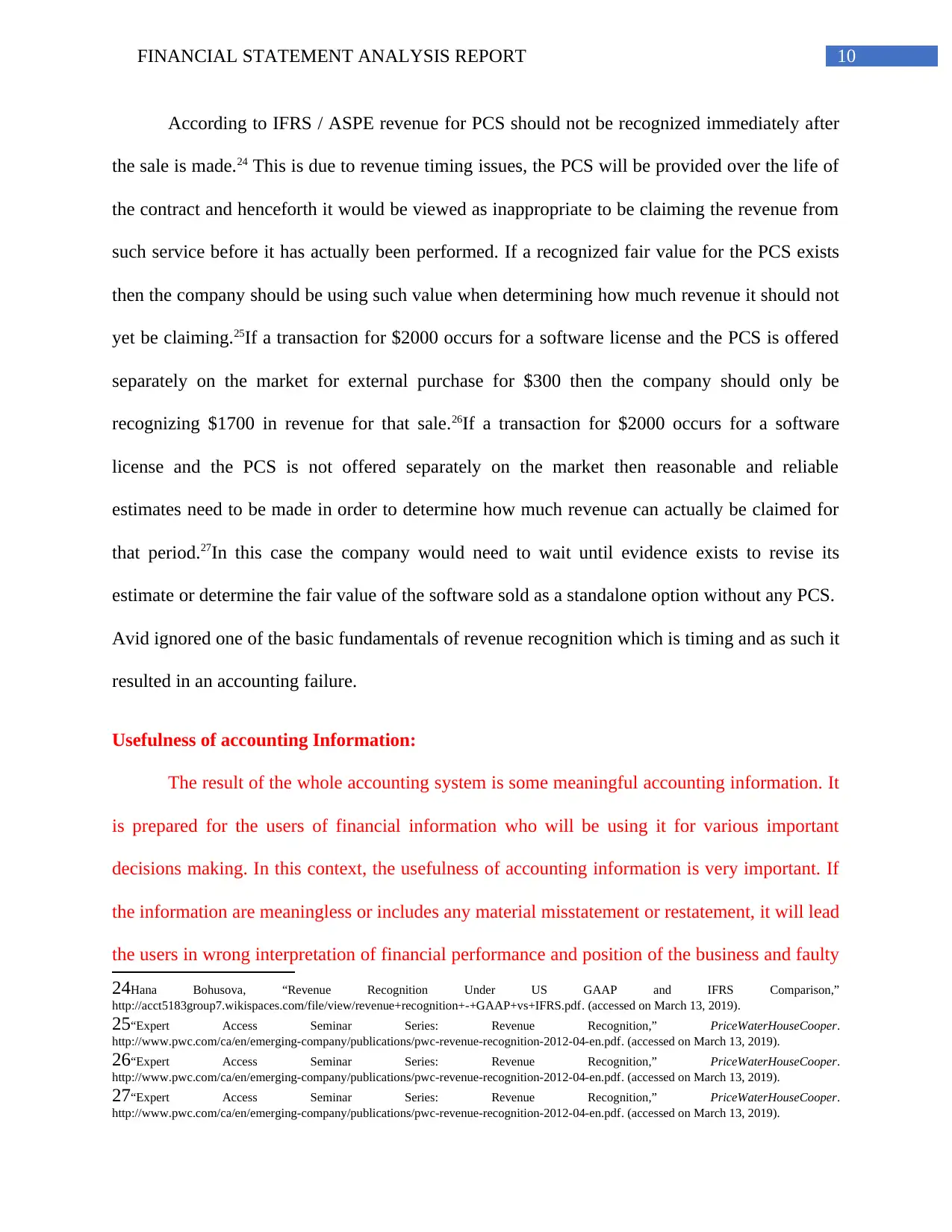
10FINANCIAL STATEMENT ANALYSIS REPORT
According to IFRS / ASPE revenue for PCS should not be recognized immediately after
the sale is made.24 This is due to revenue timing issues, the PCS will be provided over the life of
the contract and henceforth it would be viewed as inappropriate to be claiming the revenue from
such service before it has actually been performed. If a recognized fair value for the PCS exists
then the company should be using such value when determining how much revenue it should not
yet be claiming.25If a transaction for $2000 occurs for a software license and the PCS is offered
separately on the market for external purchase for $300 then the company should only be
recognizing $1700 in revenue for that sale.26If a transaction for $2000 occurs for a software
license and the PCS is not offered separately on the market then reasonable and reliable
estimates need to be made in order to determine how much revenue can actually be claimed for
that period.27In this case the company would need to wait until evidence exists to revise its
estimate or determine the fair value of the software sold as a standalone option without any PCS.
Avid ignored one of the basic fundamentals of revenue recognition which is timing and as such it
resulted in an accounting failure.
Usefulness of accounting Information:
The result of the whole accounting system is some meaningful accounting information. It
is prepared for the users of financial information who will be using it for various important
decisions making. In this context, the usefulness of accounting information is very important. If
the information are meaningless or includes any material misstatement or restatement, it will lead
the users in wrong interpretation of financial performance and position of the business and faulty
24Hana Bohusova, “Revenue Recognition Under US GAAP and IFRS Comparison,”
http://acct5183group7.wikispaces.com/file/view/revenue+recognition+-+GAAP+vs+IFRS.pdf. (accessed on March 13, 2019).
25“Expert Access Seminar Series: Revenue Recognition,” PriceWaterHouseCooper.
http://www.pwc.com/ca/en/emerging-company/publications/pwc-revenue-recognition-2012-04-en.pdf. (accessed on March 13, 2019).
26“Expert Access Seminar Series: Revenue Recognition,” PriceWaterHouseCooper.
http://www.pwc.com/ca/en/emerging-company/publications/pwc-revenue-recognition-2012-04-en.pdf. (accessed on March 13, 2019).
27“Expert Access Seminar Series: Revenue Recognition,” PriceWaterHouseCooper.
http://www.pwc.com/ca/en/emerging-company/publications/pwc-revenue-recognition-2012-04-en.pdf. (accessed on March 13, 2019).
According to IFRS / ASPE revenue for PCS should not be recognized immediately after
the sale is made.24 This is due to revenue timing issues, the PCS will be provided over the life of
the contract and henceforth it would be viewed as inappropriate to be claiming the revenue from
such service before it has actually been performed. If a recognized fair value for the PCS exists
then the company should be using such value when determining how much revenue it should not
yet be claiming.25If a transaction for $2000 occurs for a software license and the PCS is offered
separately on the market for external purchase for $300 then the company should only be
recognizing $1700 in revenue for that sale.26If a transaction for $2000 occurs for a software
license and the PCS is not offered separately on the market then reasonable and reliable
estimates need to be made in order to determine how much revenue can actually be claimed for
that period.27In this case the company would need to wait until evidence exists to revise its
estimate or determine the fair value of the software sold as a standalone option without any PCS.
Avid ignored one of the basic fundamentals of revenue recognition which is timing and as such it
resulted in an accounting failure.
Usefulness of accounting Information:
The result of the whole accounting system is some meaningful accounting information. It
is prepared for the users of financial information who will be using it for various important
decisions making. In this context, the usefulness of accounting information is very important. If
the information are meaningless or includes any material misstatement or restatement, it will lead
the users in wrong interpretation of financial performance and position of the business and faulty
24Hana Bohusova, “Revenue Recognition Under US GAAP and IFRS Comparison,”
http://acct5183group7.wikispaces.com/file/view/revenue+recognition+-+GAAP+vs+IFRS.pdf. (accessed on March 13, 2019).
25“Expert Access Seminar Series: Revenue Recognition,” PriceWaterHouseCooper.
http://www.pwc.com/ca/en/emerging-company/publications/pwc-revenue-recognition-2012-04-en.pdf. (accessed on March 13, 2019).
26“Expert Access Seminar Series: Revenue Recognition,” PriceWaterHouseCooper.
http://www.pwc.com/ca/en/emerging-company/publications/pwc-revenue-recognition-2012-04-en.pdf. (accessed on March 13, 2019).
27“Expert Access Seminar Series: Revenue Recognition,” PriceWaterHouseCooper.
http://www.pwc.com/ca/en/emerging-company/publications/pwc-revenue-recognition-2012-04-en.pdf. (accessed on March 13, 2019).
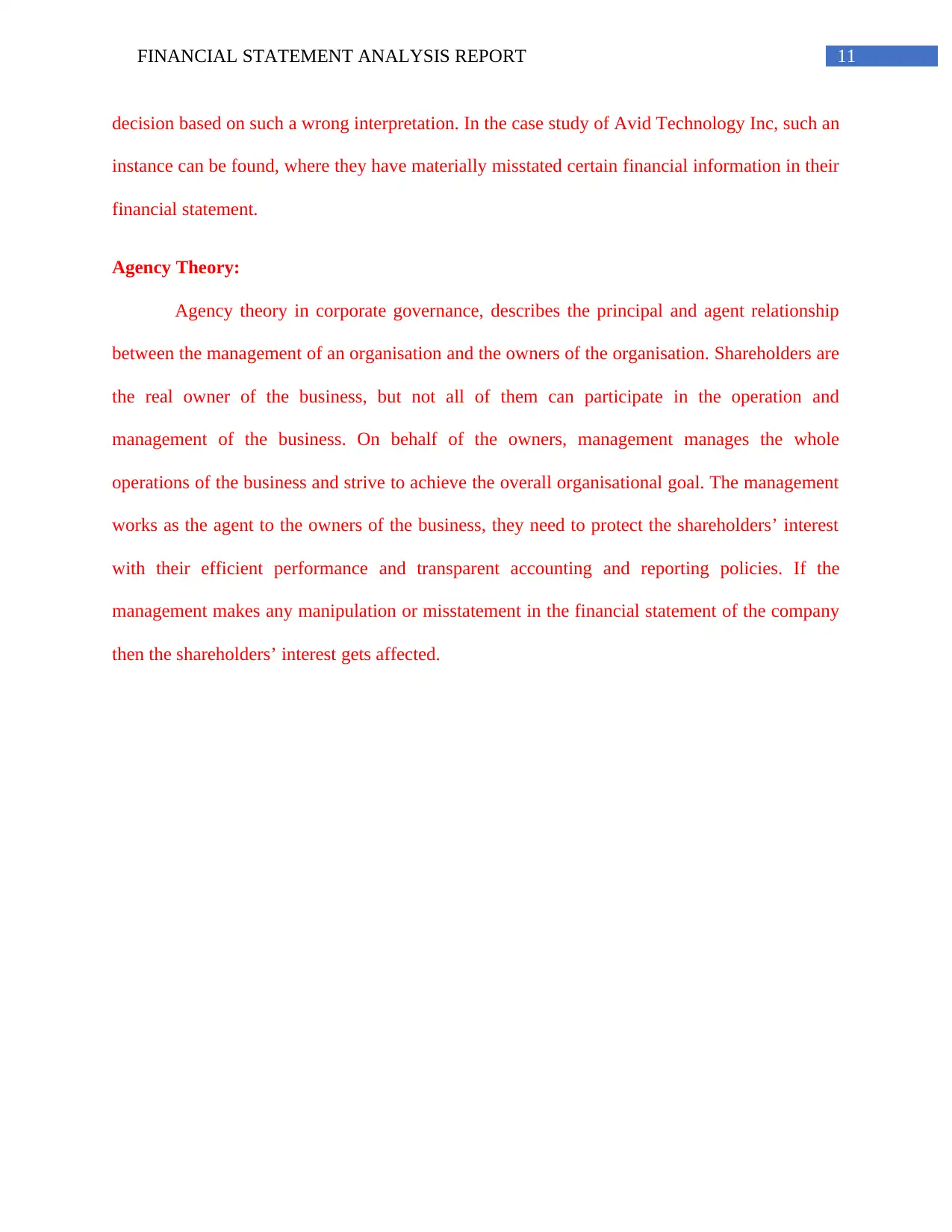
11FINANCIAL STATEMENT ANALYSIS REPORT
decision based on such a wrong interpretation. In the case study of Avid Technology Inc, such an
instance can be found, where they have materially misstated certain financial information in their
financial statement.
Agency Theory:
Agency theory in corporate governance, describes the principal and agent relationship
between the management of an organisation and the owners of the organisation. Shareholders are
the real owner of the business, but not all of them can participate in the operation and
management of the business. On behalf of the owners, management manages the whole
operations of the business and strive to achieve the overall organisational goal. The management
works as the agent to the owners of the business, they need to protect the shareholders’ interest
with their efficient performance and transparent accounting and reporting policies. If the
management makes any manipulation or misstatement in the financial statement of the company
then the shareholders’ interest gets affected.
decision based on such a wrong interpretation. In the case study of Avid Technology Inc, such an
instance can be found, where they have materially misstated certain financial information in their
financial statement.
Agency Theory:
Agency theory in corporate governance, describes the principal and agent relationship
between the management of an organisation and the owners of the organisation. Shareholders are
the real owner of the business, but not all of them can participate in the operation and
management of the business. On behalf of the owners, management manages the whole
operations of the business and strive to achieve the overall organisational goal. The management
works as the agent to the owners of the business, they need to protect the shareholders’ interest
with their efficient performance and transparent accounting and reporting policies. If the
management makes any manipulation or misstatement in the financial statement of the company
then the shareholders’ interest gets affected.
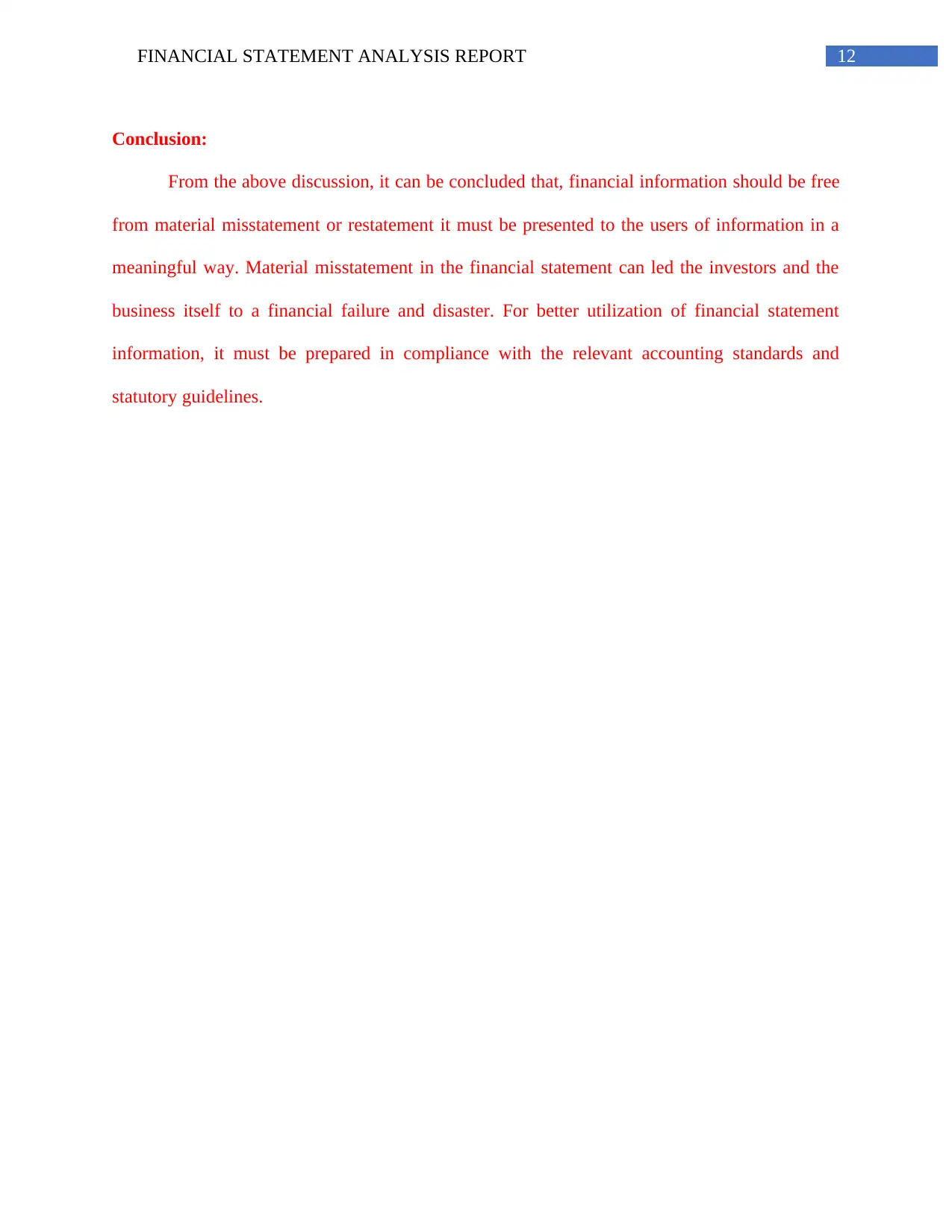
12FINANCIAL STATEMENT ANALYSIS REPORT
Conclusion:
From the above discussion, it can be concluded that, financial information should be free
from material misstatement or restatement it must be presented to the users of information in a
meaningful way. Material misstatement in the financial statement can led the investors and the
business itself to a financial failure and disaster. For better utilization of financial statement
information, it must be prepared in compliance with the relevant accounting standards and
statutory guidelines.
Conclusion:
From the above discussion, it can be concluded that, financial information should be free
from material misstatement or restatement it must be presented to the users of information in a
meaningful way. Material misstatement in the financial statement can led the investors and the
business itself to a financial failure and disaster. For better utilization of financial statement
information, it must be prepared in compliance with the relevant accounting standards and
statutory guidelines.
Paraphrase This Document
Need a fresh take? Get an instant paraphrase of this document with our AI Paraphraser

13FINANCIAL STATEMENT ANALYSIS REPORT
Appendix A:
Figure 1.1
Figure 1.2
Appendix A:
Figure 1.1
Figure 1.2

14FINANCIAL STATEMENT ANALYSIS REPORT
Figure 1.3
Figure 1.3
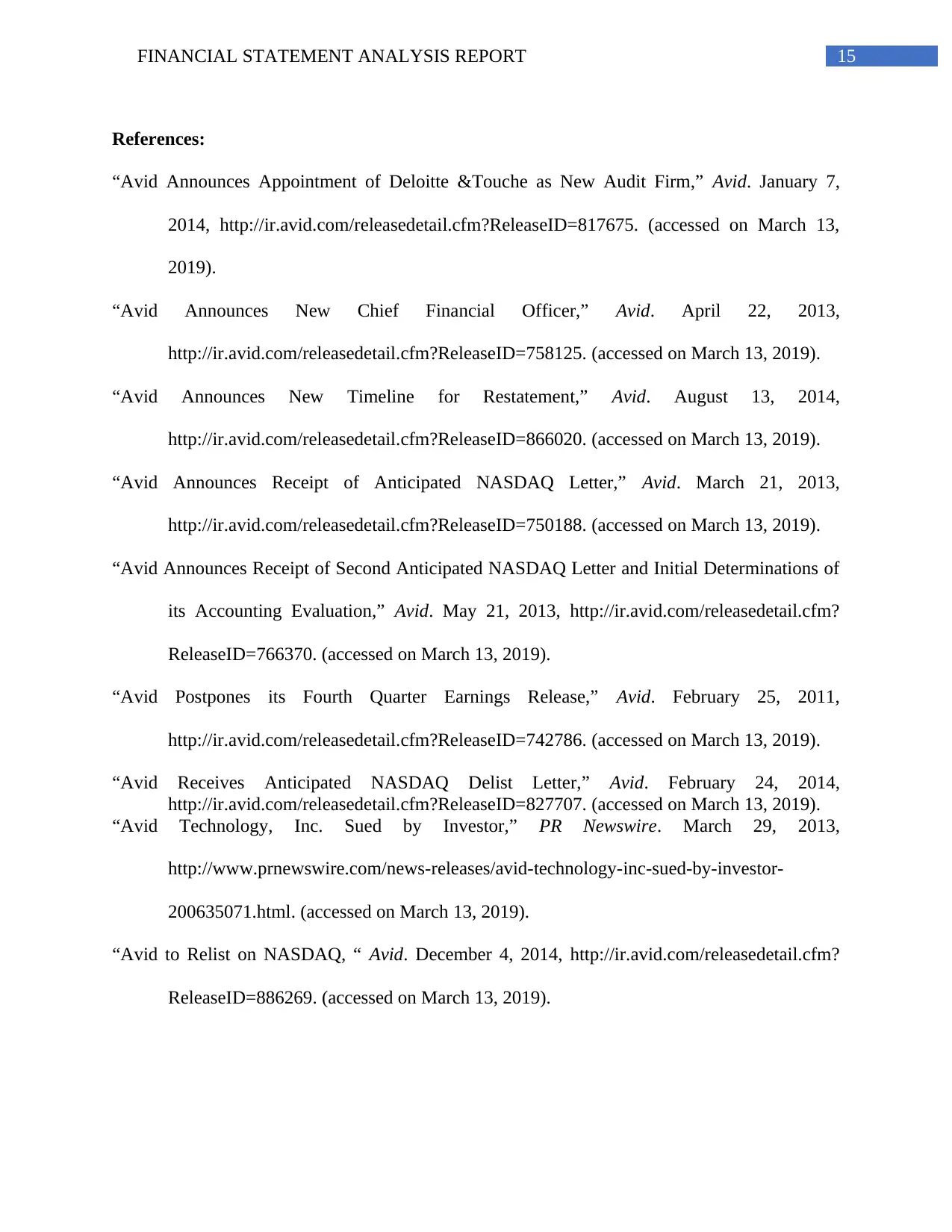
15FINANCIAL STATEMENT ANALYSIS REPORT
References:
“Avid Announces Appointment of Deloitte &Touche as New Audit Firm,” Avid. January 7,
2014, http://ir.avid.com/releasedetail.cfm?ReleaseID=817675. (accessed on March 13,
2019).
“Avid Announces New Chief Financial Officer,” Avid. April 22, 2013,
http://ir.avid.com/releasedetail.cfm?ReleaseID=758125. (accessed on March 13, 2019).
“Avid Announces New Timeline for Restatement,” Avid. August 13, 2014,
http://ir.avid.com/releasedetail.cfm?ReleaseID=866020. (accessed on March 13, 2019).
“Avid Announces Receipt of Anticipated NASDAQ Letter,” Avid. March 21, 2013,
http://ir.avid.com/releasedetail.cfm?ReleaseID=750188. (accessed on March 13, 2019).
“Avid Announces Receipt of Second Anticipated NASDAQ Letter and Initial Determinations of
its Accounting Evaluation,” Avid. May 21, 2013, http://ir.avid.com/releasedetail.cfm?
ReleaseID=766370. (accessed on March 13, 2019).
“Avid Postpones its Fourth Quarter Earnings Release,” Avid. February 25, 2011,
http://ir.avid.com/releasedetail.cfm?ReleaseID=742786. (accessed on March 13, 2019).
“Avid Receives Anticipated NASDAQ Delist Letter,” Avid. February 24, 2014,
http://ir.avid.com/releasedetail.cfm?ReleaseID=827707. (accessed on March 13, 2019).
“Avid Technology, Inc. Sued by Investor,” PR Newswire. March 29, 2013,
http://www.prnewswire.com/news-releases/avid-technology-inc-sued-by-investor-
200635071.html. (accessed on March 13, 2019).
“Avid to Relist on NASDAQ, “ Avid. December 4, 2014, http://ir.avid.com/releasedetail.cfm?
ReleaseID=886269. (accessed on March 13, 2019).
References:
“Avid Announces Appointment of Deloitte &Touche as New Audit Firm,” Avid. January 7,
2014, http://ir.avid.com/releasedetail.cfm?ReleaseID=817675. (accessed on March 13,
2019).
“Avid Announces New Chief Financial Officer,” Avid. April 22, 2013,
http://ir.avid.com/releasedetail.cfm?ReleaseID=758125. (accessed on March 13, 2019).
“Avid Announces New Timeline for Restatement,” Avid. August 13, 2014,
http://ir.avid.com/releasedetail.cfm?ReleaseID=866020. (accessed on March 13, 2019).
“Avid Announces Receipt of Anticipated NASDAQ Letter,” Avid. March 21, 2013,
http://ir.avid.com/releasedetail.cfm?ReleaseID=750188. (accessed on March 13, 2019).
“Avid Announces Receipt of Second Anticipated NASDAQ Letter and Initial Determinations of
its Accounting Evaluation,” Avid. May 21, 2013, http://ir.avid.com/releasedetail.cfm?
ReleaseID=766370. (accessed on March 13, 2019).
“Avid Postpones its Fourth Quarter Earnings Release,” Avid. February 25, 2011,
http://ir.avid.com/releasedetail.cfm?ReleaseID=742786. (accessed on March 13, 2019).
“Avid Receives Anticipated NASDAQ Delist Letter,” Avid. February 24, 2014,
http://ir.avid.com/releasedetail.cfm?ReleaseID=827707. (accessed on March 13, 2019).
“Avid Technology, Inc. Sued by Investor,” PR Newswire. March 29, 2013,
http://www.prnewswire.com/news-releases/avid-technology-inc-sued-by-investor-
200635071.html. (accessed on March 13, 2019).
“Avid to Relist on NASDAQ, “ Avid. December 4, 2014, http://ir.avid.com/releasedetail.cfm?
ReleaseID=886269. (accessed on March 13, 2019).
Secure Best Marks with AI Grader
Need help grading? Try our AI Grader for instant feedback on your assignments.
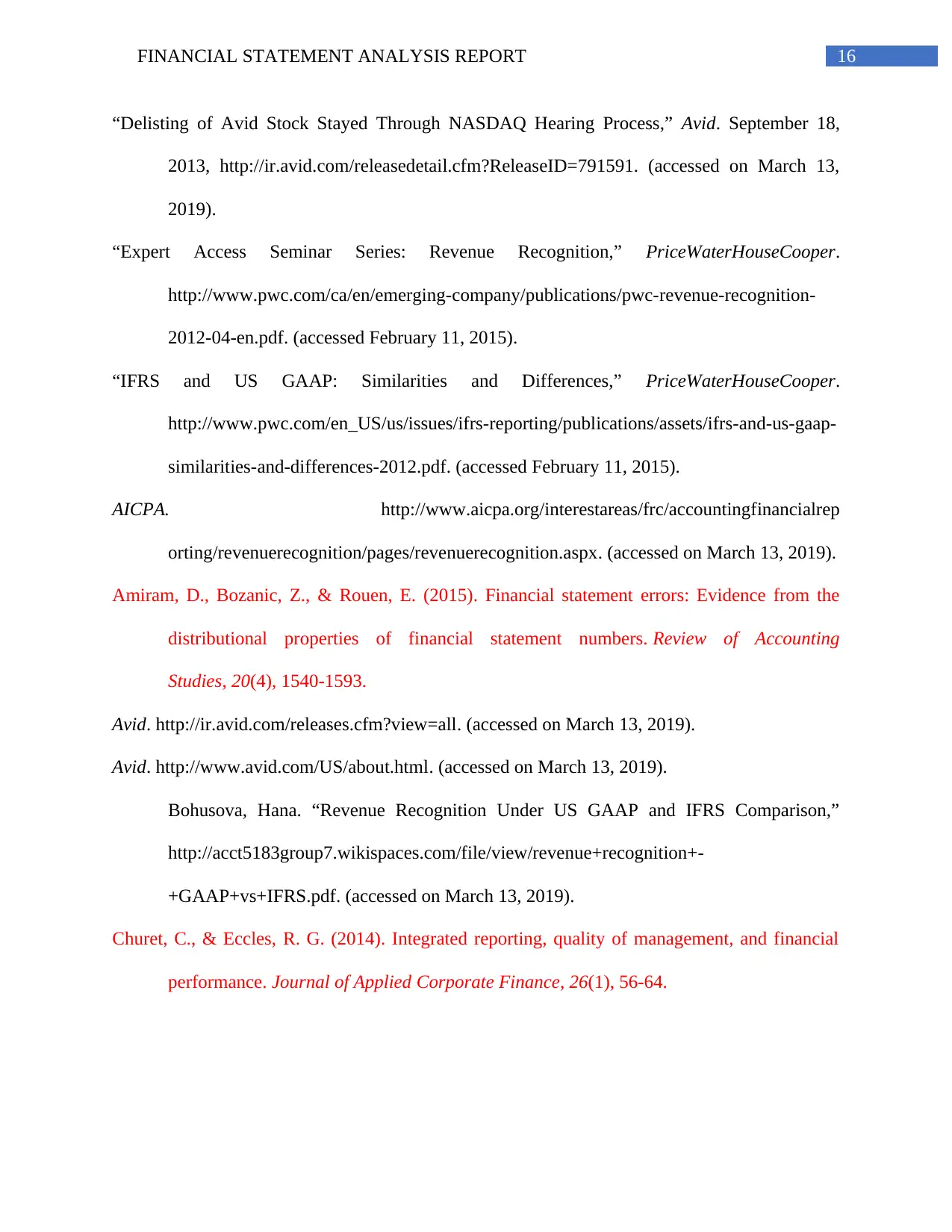
16FINANCIAL STATEMENT ANALYSIS REPORT
“Delisting of Avid Stock Stayed Through NASDAQ Hearing Process,” Avid. September 18,
2013, http://ir.avid.com/releasedetail.cfm?ReleaseID=791591. (accessed on March 13,
2019).
“Expert Access Seminar Series: Revenue Recognition,” PriceWaterHouseCooper.
http://www.pwc.com/ca/en/emerging-company/publications/pwc-revenue-recognition-
2012-04-en.pdf. (accessed February 11, 2015).
“IFRS and US GAAP: Similarities and Differences,” PriceWaterHouseCooper.
http://www.pwc.com/en_US/us/issues/ifrs-reporting/publications/assets/ifrs-and-us-gaap-
similarities-and-differences-2012.pdf. (accessed February 11, 2015).
AICPA. http://www.aicpa.org/interestareas/frc/accountingfinancialrep
orting/revenuerecognition/pages/revenuerecognition.aspx. (accessed on March 13, 2019).
Amiram, D., Bozanic, Z., & Rouen, E. (2015). Financial statement errors: Evidence from the
distributional properties of financial statement numbers. Review of Accounting
Studies, 20(4), 1540-1593.
Avid. http://ir.avid.com/releases.cfm?view=all. (accessed on March 13, 2019).
Avid. http://www.avid.com/US/about.html. (accessed on March 13, 2019).
Bohusova, Hana. “Revenue Recognition Under US GAAP and IFRS Comparison,”
http://acct5183group7.wikispaces.com/file/view/revenue+recognition+-
+GAAP+vs+IFRS.pdf. (accessed on March 13, 2019).
Churet, C., & Eccles, R. G. (2014). Integrated reporting, quality of management, and financial
performance. Journal of Applied Corporate Finance, 26(1), 56-64.
“Delisting of Avid Stock Stayed Through NASDAQ Hearing Process,” Avid. September 18,
2013, http://ir.avid.com/releasedetail.cfm?ReleaseID=791591. (accessed on March 13,
2019).
“Expert Access Seminar Series: Revenue Recognition,” PriceWaterHouseCooper.
http://www.pwc.com/ca/en/emerging-company/publications/pwc-revenue-recognition-
2012-04-en.pdf. (accessed February 11, 2015).
“IFRS and US GAAP: Similarities and Differences,” PriceWaterHouseCooper.
http://www.pwc.com/en_US/us/issues/ifrs-reporting/publications/assets/ifrs-and-us-gaap-
similarities-and-differences-2012.pdf. (accessed February 11, 2015).
AICPA. http://www.aicpa.org/interestareas/frc/accountingfinancialrep
orting/revenuerecognition/pages/revenuerecognition.aspx. (accessed on March 13, 2019).
Amiram, D., Bozanic, Z., & Rouen, E. (2015). Financial statement errors: Evidence from the
distributional properties of financial statement numbers. Review of Accounting
Studies, 20(4), 1540-1593.
Avid. http://ir.avid.com/releases.cfm?view=all. (accessed on March 13, 2019).
Avid. http://www.avid.com/US/about.html. (accessed on March 13, 2019).
Bohusova, Hana. “Revenue Recognition Under US GAAP and IFRS Comparison,”
http://acct5183group7.wikispaces.com/file/view/revenue+recognition+-
+GAAP+vs+IFRS.pdf. (accessed on March 13, 2019).
Churet, C., & Eccles, R. G. (2014). Integrated reporting, quality of management, and financial
performance. Journal of Applied Corporate Finance, 26(1), 56-64.
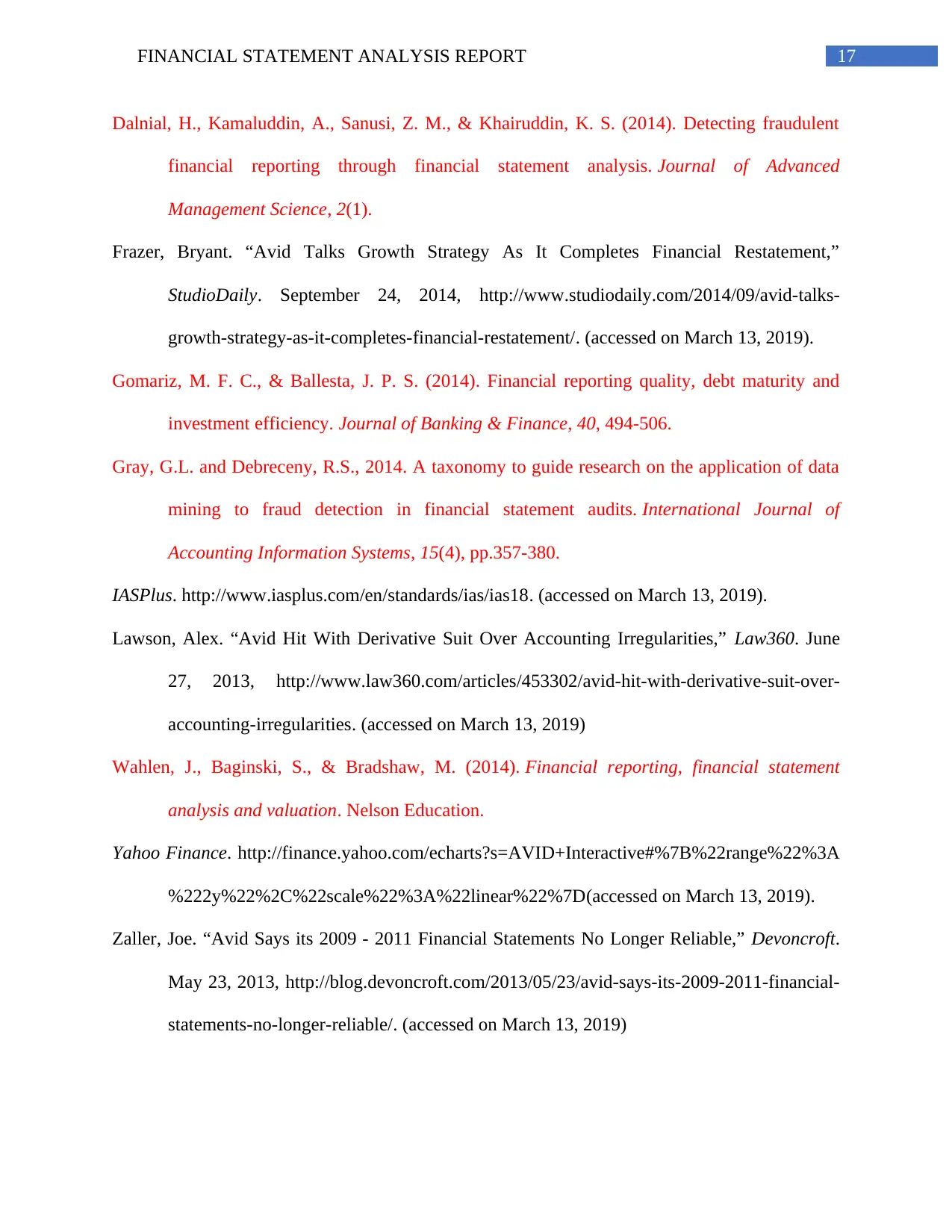
17FINANCIAL STATEMENT ANALYSIS REPORT
Dalnial, H., Kamaluddin, A., Sanusi, Z. M., & Khairuddin, K. S. (2014). Detecting fraudulent
financial reporting through financial statement analysis. Journal of Advanced
Management Science, 2(1).
Frazer, Bryant. “Avid Talks Growth Strategy As It Completes Financial Restatement,”
StudioDaily. September 24, 2014, http://www.studiodaily.com/2014/09/avid-talks-
growth-strategy-as-it-completes-financial-restatement/. (accessed on March 13, 2019).
Gomariz, M. F. C., & Ballesta, J. P. S. (2014). Financial reporting quality, debt maturity and
investment efficiency. Journal of Banking & Finance, 40, 494-506.
Gray, G.L. and Debreceny, R.S., 2014. A taxonomy to guide research on the application of data
mining to fraud detection in financial statement audits. International Journal of
Accounting Information Systems, 15(4), pp.357-380.
IASPlus. http://www.iasplus.com/en/standards/ias/ias18. (accessed on March 13, 2019).
Lawson, Alex. “Avid Hit With Derivative Suit Over Accounting Irregularities,” Law360. June
27, 2013, http://www.law360.com/articles/453302/avid-hit-with-derivative-suit-over-
accounting-irregularities. (accessed on March 13, 2019)
Wahlen, J., Baginski, S., & Bradshaw, M. (2014). Financial reporting, financial statement
analysis and valuation. Nelson Education.
Yahoo Finance. http://finance.yahoo.com/echarts?s=AVID+Interactive#%7B%22range%22%3A
%222y%22%2C%22scale%22%3A%22linear%22%7D(accessed on March 13, 2019).
Zaller, Joe. “Avid Says its 2009 - 2011 Financial Statements No Longer Reliable,” Devoncroft.
May 23, 2013, http://blog.devoncroft.com/2013/05/23/avid-says-its-2009-2011-financial-
statements-no-longer-reliable/. (accessed on March 13, 2019)
Dalnial, H., Kamaluddin, A., Sanusi, Z. M., & Khairuddin, K. S. (2014). Detecting fraudulent
financial reporting through financial statement analysis. Journal of Advanced
Management Science, 2(1).
Frazer, Bryant. “Avid Talks Growth Strategy As It Completes Financial Restatement,”
StudioDaily. September 24, 2014, http://www.studiodaily.com/2014/09/avid-talks-
growth-strategy-as-it-completes-financial-restatement/. (accessed on March 13, 2019).
Gomariz, M. F. C., & Ballesta, J. P. S. (2014). Financial reporting quality, debt maturity and
investment efficiency. Journal of Banking & Finance, 40, 494-506.
Gray, G.L. and Debreceny, R.S., 2014. A taxonomy to guide research on the application of data
mining to fraud detection in financial statement audits. International Journal of
Accounting Information Systems, 15(4), pp.357-380.
IASPlus. http://www.iasplus.com/en/standards/ias/ias18. (accessed on March 13, 2019).
Lawson, Alex. “Avid Hit With Derivative Suit Over Accounting Irregularities,” Law360. June
27, 2013, http://www.law360.com/articles/453302/avid-hit-with-derivative-suit-over-
accounting-irregularities. (accessed on March 13, 2019)
Wahlen, J., Baginski, S., & Bradshaw, M. (2014). Financial reporting, financial statement
analysis and valuation. Nelson Education.
Yahoo Finance. http://finance.yahoo.com/echarts?s=AVID+Interactive#%7B%22range%22%3A
%222y%22%2C%22scale%22%3A%22linear%22%7D(accessed on March 13, 2019).
Zaller, Joe. “Avid Says its 2009 - 2011 Financial Statements No Longer Reliable,” Devoncroft.
May 23, 2013, http://blog.devoncroft.com/2013/05/23/avid-says-its-2009-2011-financial-
statements-no-longer-reliable/. (accessed on March 13, 2019)
1 out of 18
Your All-in-One AI-Powered Toolkit for Academic Success.
+13062052269
info@desklib.com
Available 24*7 on WhatsApp / Email
![[object Object]](/_next/static/media/star-bottom.7253800d.svg)
Unlock your academic potential
© 2024 | Zucol Services PVT LTD | All rights reserved.